LG Electronics USA L1100 Single-Band PCS GSM Phone User Manual
LG Electronics USA Single-Band PCS GSM Phone Users Manual
Users Manual

ENGLISH
GPRS Phone
USER’S MANUAL
MODEL: L1100
Please read this manual carefully
before operating your mobile phone.
Retain it for future reference.
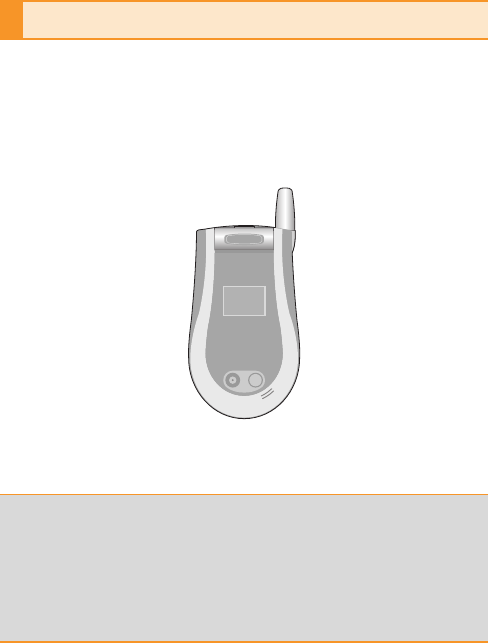
This user’s guide contains important information on the use and
operation of this phone. Please read all the information carefully
for optimal performance and to prevent any damage to or misuse
of the phone. Any changes or modifications not expressly
approved in this user’s guide could void your warranty for this
equipment.
Introduction
Congratulations on your purchase of the advanced and
compact L1100 mobile phone, designed to operate with
the latest digital mobile communication technology.

3
Read these simple guidelines. Breaking the rules may be
dangerous or illegal. Further detailed information is given in this
manual.
Exposure to radio frequency energy
Radio wave exposure and Specific
Absorption Rate (SAR) information
This mobile phone model L1100 has been designed to comply with
applicable safety requirement for exposure to radio waves. This
requirement is based on scientific guidelines that include safety
margins designed to assure this safety of all persons, regardless of
age and health.
• The radio wave exposure guidelines employ a unit of
measurement known as the Specific Absorption Rate, or SAR.
Tests for SAR are conducted using standardized method with the
phone transmitting at its highest certified power level in all used
frequency bands.
• While there may be differences between the SAR levels of
various LG phone models, they are all designed to meet the
relevant guidelines for exposure to radio waves.
• The SAR limit recommended by the international Commission on
Non-Ionizing Radiation Protection (ICNIRP), which is 2W/kg
averaged over ten (10) gram of tissue.
• The highest SAR value for this model phone tested by DASY4
for use at the ear is 0.712 W/kg (10g).
• SAR data information for residents in countries/regions that have
adopted the SAR limit recommended by the Institute of Electrical
and Electronics Engineers (IEEE), which is 1.6 W/kg averaged
over one (1) gram of tissue (for example USA, Canada, Australia
and Taiwan).
Guidelines for safe and efficient use

4
Product care and maintenance
Warning: Use only batteries, charger and accessories
approved for use with this particular phone model. The use of
any other types may invalidate any approval or warranty
applying to the phone, and may be dangerous.
• Do not disassemble this unit. Take it to a qualified service
technician when repair work is required.
• Keep away from electrical appliance such as a TV, radio or
personal computer.
• The unit should be kept away from heat sources such as
radiators or cookers.
• Do not drop.
• Do not subject this unit to mechanical vibration or shock.
• The coating of the phone may be damaged if covered with wrap
or vinyl wrapper.
• Use dry cloth to clean the exterior of the unit.
(Do not use solvent such as benzene, thinner or alcohol.)
• Do not subject this unit to excessive smoke or dust.
• Do not keep the phone next to credit cards or transport tickets;
it can affect the information on the magnetic strips.
• Do not tap the screen with a sharp object; otherwise, it may
damage the phone.
• Do not expose the phone to liquid or moisture.
• Use the accessories like an earphone cautiously.
Do not touch the antenna unnecessarily.
Guidelines for safe and efficient use

Efficient phone operation
To enjoy optimum performance with minimum power consumption
please:
• Hold the phone as you speak to any other telephone. While
speaking directly into the microphone, angle the antenna in a
direction up and over your shoulder. If the antenna is extendable/
retractable, it should be extended during a call.
• Do not hold the antenna when the phone is in use. If you hold it, it
can affect call quality, it also may cause the phone to operate as
a higher power level that needed and shorten talk and standby
times.
• If your mobile phone supports infrared, never direct the infrared
ray at anyone’s eye.
Electronics devices
All mobile phones may get interference, which could affect
performance.
• Do not use your mobile phone near medical equipment without
requesting permission. Avoid placing the phone over the
pacemaker, i.e. in your breast pocket.
• Some hearing aids might be disturbed by mobile phones.
• Minor interference may affect TVs, radios, PCs, etc.
5

Road safety
Check the laws and regulations on the use of mobile phones in the
areas when you drive.
• Do not use a hand-held phone while driving.
• Give full attention to driving.
• Use a hands-free kit, if available.
• Pull off the road and park before making or answering a call if
driving conditions so require.
• RF energy may affect some electronic systems in your motor
vehicle such as car stereo, safety equipment.
• When your vehicle is equipped with an air bag, do not obstruct
with installed or portable wireless equipment. It can cause
serious injury due to improper performance.
Blasting area
Do not use the phone where blasting is in progress. Observe
restrictions, and follow any regulations or rules.
Potentially explosive atmospheres
• Do not use the phone at a refueling point. Don’t use near fuel or
chemicals.
• Do not transport or store flammable gas, liquid, or explosives in
the compartment of your vehicle, which contains your mobile
phone and accessories.
In aircraft
Wireless devices can cause interference in aircraft.
• Turn off your mobile phone before boarding any aircraft.
• Do not use it on the ground without crew permission.
6
Guidelines for safe and efficient use

Children
Keep the phone in a safe place out of children’s reach. It includes
small parts which if detached may cause a choking hazard.
Emergency calls
Emergency calls may not be available under all cellular networks.
Therefore, you should never depend solely on the phone for
emergency calls. Check with your local service provider.
Battery information and care
• You do not need to completely discharge the battery before
recharging. Unlike other battery systems, there is no memory
effect that could compromise the battery’s performance.
• Use only LG batteries and chargers. LG chargers are designed to
maximize the battery life.
• Do not disassemble or short-circuit the battery pack.
• Keep the metal contacts of the battery pack clean.
• Replace the battery when it no longer provides acceptable
performance. The battery pack may be recharged hundreds of
times until it needs replacing.
• Recharge the battery if it has not been used for a long time to
maximize usability.
• Do not expose the battery charger to direct sunlight or use it in
high humidity, such as the bathroom.
• Do not leave the battery in hot or cold places, this may deteriorate
the battery performance.
7

Important Information
This user guide contains important information on the use and
operation of this phone. Please read all the information carefully for
optimal performance and to prevent any damage to, or misuse of,
the phone. Any changes or modifications not expressly approved in
this user guide could void your warranty for this equipment.
Before You Start
Safety Instructions
WARNING! To reduce the possibility of electric shock, do not
expose your phone to high humidity areas, such as the bathroom,
swimming pool, etc.
Always store your phone away from heat. Never store your
phone in settings that may expose it to temperatures less than 32°F
or greater than 104°F, such as outside during a snowstorm or in
your car on a hot day. Exposure to excessive cold or heat will result
in malfunction, damage and/or catastrophic failure.
Be careful when using your phone near other electronic
devices. RF emissions from your mobile phone may affect nearby
inadequately shielded electronic equipment. You should consult
with manufacturers of any personal medical devices such as
pacemakers and hearing aides to determine if they are susceptible
to interference from your mobile phone. Turn off your phone in a
medical facility or at a gas station. Never place your phone in a
microwave oven as this will cause the battery to explode.
IMPORTANT! Please read the TIA SAFETY INFORMATION on
page 103 before using your phone.
Safety Information
Please read and observe the following information for the safe and
proper use of your phone and to prevent any unanticipated damage.
Also, keep the user’s manual in an accessible place at all times
after reading it.
8
For Your Safety

• Unplug the power cord and charger during a lightning storm to
avoid electric shock or fire.
• Do not use your phone in high explosive areas as the phone may
generate sparks.
• Do not put your phone in a place subject to excessive dust, and
keep the minimum required distance between the power cord and
heat sources.
• Do not damage the power cord by bending, twisting, pulling, or
subjecting it to heat. Do not use the plug if it is loose as it may
cause fire or electric shock.
• Hold the power cord plug firmly to plug and unplug the power
cord. Ensure the plug is firmly connected. If it is not firmly
connected, it may cause excessive heat or fire.
• Do not place a heavy item on the power cord. Do not allow the
power cord to be crimped as it may cause fire or electric shock.
• Be careful not to let the battery contact metal conductors such as
a necklace or coins. When shorted, it may cause an explosion.
• Do not disassemble or impact the battery as it may cause electric
shock, short-circuit, and fire. Store the battery in a place out of
reach of children.
• Using a damaged battery or placing a battery in your mouth may
cause serious injury.
• Do not place items containing magnetic components such as a
credit card, phone card, bank book or a subway ticket, near your
phone. The magnetic strip can be damaged by the phone.
• Do not hold or let the antenna come in contact with your body
during a call.
• Talking on your phone for a long period of time may reduce the
call quality due to heat generated during the use of the phone.
• Do not allow excessive vibration or impact to the phone.
• When you do not plan to use the phone for a long period of time,
store it in a safe area with the power cord unplugged.
9

FCC RF Exposure Information
WARNING! Read this information before operating the phone.
In August 1996, the Federal Communications (FCC) of the United
States, with its action in Report and Order FCC 96-326, adopted an
updated safety standard for human exposure to radio frequency
(RF) electromagnetic energy emitted by FCC regulated transmitters.
Those guidelines are consistent with the safety standard previously
set by both U.S. and international standards bodies.
The design of this phone complies with the FCC guidelines and
these international standards.
CAUTION
Use only the supplied and approved antenna. Use of unauthorized
antennas or modifications could impair call quality, damage the
phone, void your warranty and/or result in violation of FCC
regulations.
Do not use the phone with a damaged antenna. If a damaged
antenna comes into contact with skin, a minor burn may result.
Contact your local dealer for a replacement antenna.
Body-worn Operation
This device was tested for typical body-worn operations with the
back of the phone kept 1.5 cm between the user's body and the back
of the phone. To comply with FCC RF exposure requirements, a
minimum separation distance of 1.5 cm must be maintained
between the user’s body and the back of the phone. Third-party
belt-clips, holsters, and similar accessories containing metallic
components should not be used. Body-worn accessories that
cannot maintain 0.6 inches (1.5 cm) separation distance between the
user’s body and the back of the phone, and have not been tested
for typical body-worn operations may not comply with FCC RF
exposure limits and should be avoided.
10
For Your Safety

Vehicle Mounted External Antenna
(optional, if available)
A minimum separation distance of 8 inches (20 cm) must be
maintained between the user/bystander and the vehicle mounted
external antenna to satisfy FCC RF exposure requirements.
For more information about RF exposure, visit the FCC website at
www.fcc.gov.
FCC Part 15 Class B Compliance
This device and its accessories comply with part 15 of FCC rules.
Operation is subject to the following two conditions: (1) This device
and its accessories may not cause harmful interference, and (2) this
device and its accessories must accept any interference received,
including interference that may cause undesired operation.
Cautions for Battery
• Do not disassemble.
• Do not short-circuit.
• Do not expose to high temperature: 60°C (140°F).
• Do not incinerate.
Battery Disposal
• Please dispose of your battery properly or bring to your local
wireless carrier for recycling.
• Do not dispose in fire or with hazardous or flammable materials.
Adapter (Charger) Cautions
• Using the wrong battery charger could damage your phone and
void your warranty.
• The adapter or battery charger is intended for indoor use only.
Do not expose the adapter or battery charger to direct sunlight or
use it in places with high humidity, such as the bathroom.
11

12
Your phone .............................................................................. 16
• Phone components ............................................................... 16
• Your phone’s features ........................................................... 17
• Side of the Key ..................................................................... 18
• Display information ............................................................... 18
Getting started ........................................................................ 20
• Installing the SIM card and the handset battery ................... 20
• Charging the battery ............................................................. 21
• Disconnecting the adapter .................................................... 22
• Turning your phone on and off .............................................. 23
• Access codes ........................................................................ 24
General functions ................................................................... 26
• Making and answering calls .................................................. 26
• Entering text .......................................................................... 28
• Address book ....................................................................... 32
• In-call menu .......................................................................... 32
• Multiparty or conference calls ............................................... 34
• Call register............................................................................ 38
• Camera ................................................................................. 42
Menu tree ................................................................................. 45
Selecting functions and options ........................................... 47
Broswer [Menu 1] .................................................................... 48
• Home [Menu 1-1] .................................................................. 49
• Bookmarks [Menu 1-2] .......................................................... 49
• Go to URL [Menu 1-3] ........................................................... 49
• Service messages [Menu 1-4] ...............................................50
Contents

13
• Cache settings [Menu 1-5] .................................................... 50
• Account settings [Menu 1-6] ................................................. 51
• Security [Menu 1-7] ............................................................... 51
Profiles [Menu 2] ..................................................................... 52
Extras [Menu 3] ....................................................................... 54
• Calendar [Menu 3-1] ............................................................. 54
• Memo [Menu 3-2] .................................................................. 55
• Alarm clock [Menu 3-3] ......................................................... 56
• Voice recorder [Menu 3-4] .................................................... 56
• Calculator [Menu 3-5] ............................................................ 57
• Unit converter [Menu 3-6] ..................................................... 58
• World time [Menu 3-7] ........................................................... 59
• Activate IrDA [Menu 3-8] ....................................................... 60
Orange World [Menu 4] .......................................................... 61
• Orange World [Menu 4-1] ..................................................... 61
• Your page [Menu 4-2] ........................................................... 61
• Channel guide [Menu 4-3] .................................................... 61
• Your phone [Menu 4-4] ......................................................... 61
• Orange PLUS [Menu 4-5] ..................................................... 61
Messages [Menu 5] ................................................................. 62
• Text message [Menu 5-1] ...................................................... 62
• Picture message [Menu 5-2] ................................................. 67
• Answer phone [Menu 5-3] ..................................................... 73
• Info messages [Menu 5-4] .................................................... 73
• Templates [Menu 5-5] ........................................................... 75
• Memory status [Menu 5-6] .................................................... 77

14
Media album [Menu 6] ............................................................ 78
• Picture [Menu 6-1] ................................................................. 78
• Animation [Menu 6-2] ............................................................ 78
• Sound [Menu 6-3] ................................................................. 78
• Memory status [Menu 6-4] .................................................... 78
Apps & Games [Menu 7] ......................................................... 79
• Applications [Menu 7-1] ........................................................ 79
• Games [Menu 7-2] ................................................................ 80
• Download [Menu 7-3] ............................................................ 71
• Information [Menu 7-4] .......................................................... 82
Address book [Menu 8] .......................................................... 83
• Search [Menu 8-1] ................................................................ 83
• Add new [Menu 8-2] .............................................................. 84
• Speed dials [Menu 8-3] ..........................................................85
• Voice list [Menu 8-4] ............................................................ 86
• Caller groups [Menu 8-5] ...................................................... 87
• Copy all [Menu 8-6] ............................................................... 88
• Delete all [Menu 8-7] ............................................................. 88
• Settings [Menu 8-8] ............................................................... 88
• Information [Menu 8-9] .......................................................... 89
Settings [Menu 9] .................................................................... 90
• Date & Time [Menu 9-1] ........................................................ 90
• Display settings [Menu 9-2] ................................................... 90
• Call settings [Menu 9-3] ........................................................ 92
• Network settings [Menu 9-4] ................................................. 96
• GPRS settings [Menu 9-5] .................................................... 97
Contents

15
• Security settings [Menu 9-6] ................................................. 98
• Reset settings [Menu 9-7] ................................................... 102
Q&A ........................................................................................ 103
Safety Guidelines .................................................................. 106
• FDA Consumer Update ....................................................... 106
• Consumer Information on SAR ........................................... 114
Accessories ........................................................................... 116
Technical Data ....................................................................... 117
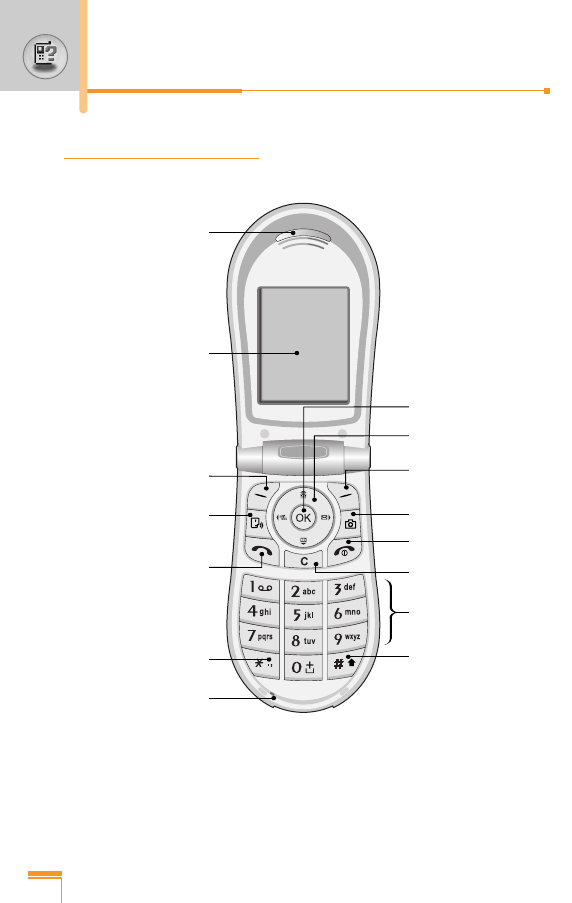
Phone components
Earpiece
LCD Screen
Left soft Key
Orange key
Send Key
Star Key
Microphone
Right soft Key
Camera key
End/Power Key
Clear Key
Alphanumeric keys
Hash Key
Confirm key
Navigation keys
16
Your phone
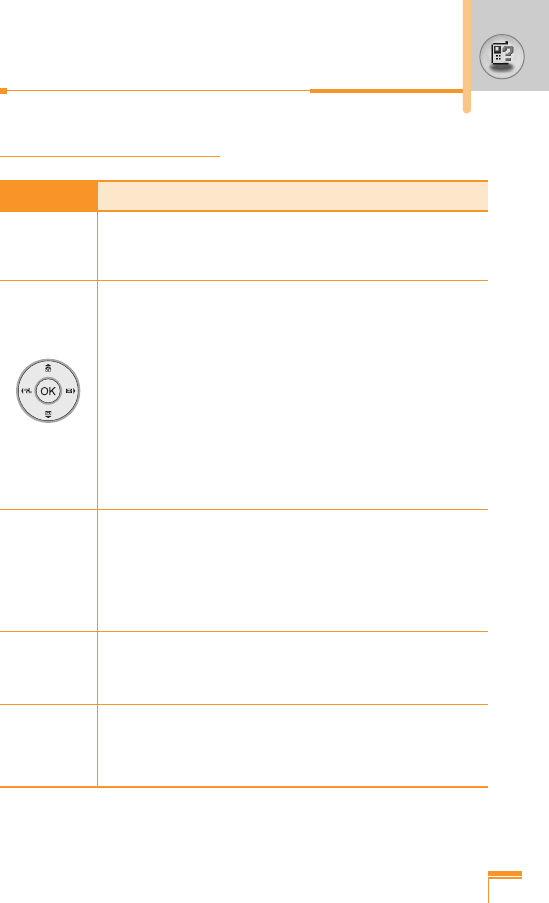
17
Your phone’s features
Key Description
Left soft key / Right soft key
<> Each of these keys performs the function indicated
by the text on the screen immediately above it.
Navigation keys
Use for quick access to phone functions.
• Up navigation key
By pressing this key in standby mode, you can
move the bottom of the address book.
• Down navigation key
You can move the top of the address book.
• Left/ Right navigation key
A shortcut key to the Orange world menu.
OK key (=Confirm key)
Selects menu options and confirms actions.
Send Key
SDials a phone number and answers incoming calls.
You can also quickly access the latest incoming,
outgoing and missed calls by pressing the key in
standby mode. In standby mode, you can access call
register menu if you press this key for a long time.
Alphanumeric keys
Enter numbers, letters and some special characters.
End / Power key
EUsed to end a call or reject a call and also to go back
to standby mode. Hold this key down to turn the
phone on/off.
~
0
9
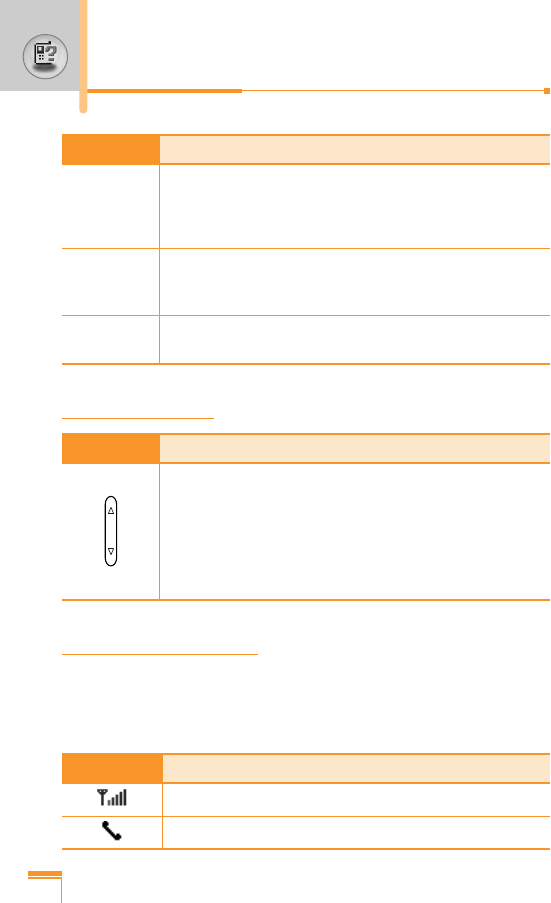
18
Side of the Key
Key Description
Clear key
CDeletes a character by each press. Hold the key
down to clear all input all input. Also use this key to
go back to the previous screen.
QCamera key
Press this key to use the camera feature. Directly
goes to the camera mode.
TOrange key
A shortcut key to Orange world menu.
Key Description
Side Key
• Controls the volume of key tone in standby mode
with the sliding keypad down.
• Controls the earpiece volume during a phone call.
• With the sliding keypad up, pressing one of these
displays the current time and date by turns.
Display information
The table below describes various display indicators or icons that
appear on the phone’s display screen.
On-Screen Icons
Icon Description
Indicates the strength of the network signal.
Indicates a call is in progress.
Your phone
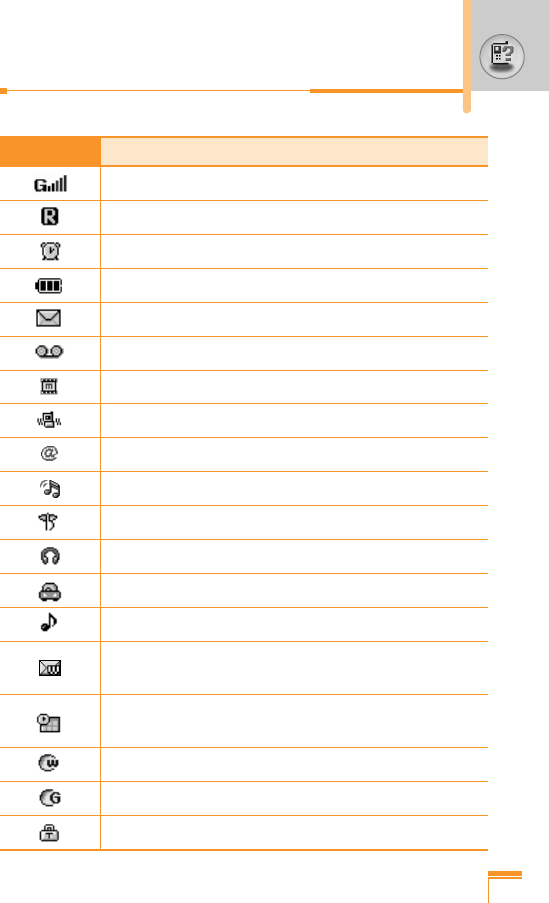
19
Icon Description
Indicates that GPRS service is available.
Indicates that you are roaming on another network.
Indicates the alarm has been set and is on.
Indicates the status of the battery charge.
Indicates the receipt of a text message.
Indicates the receipt of a voice message.
Indicates the receipt of a MMS message.
Indicates that the vibration ringer has been set.
Indicates the receipt of an e-mail message.
Indicates the Loud profile is activated.
Indicates the Silent profile is activated.
Indicates the Headset profile is activated.
Indicates the Car profile is activated.
Indicates the General profile is activated.
Indicates that you can use the push message
service.
Indicates that you have a schedule for the selected
day in the schedule menu.
Indicates that the phone is accessing the WAP.
Indicates that you are using GPRS.
Indicates that you entered the security page.
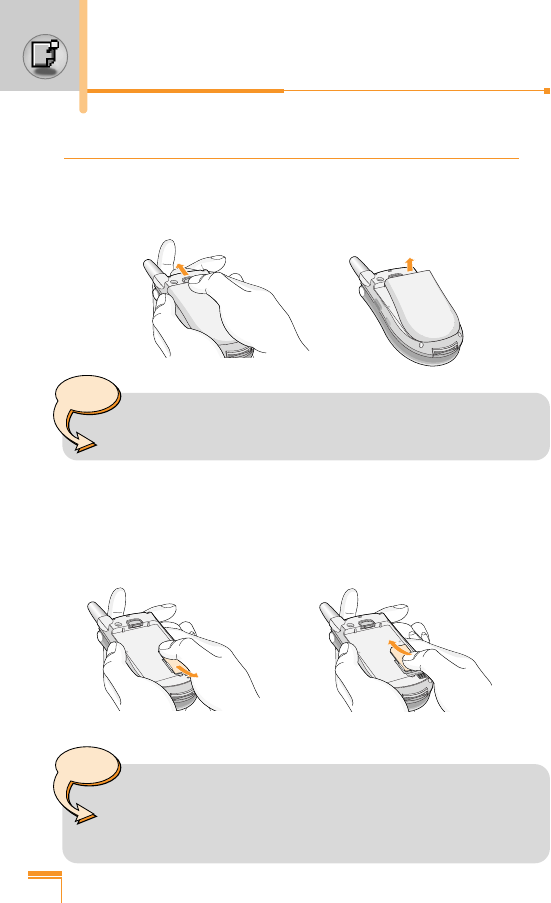
20
Installing the SIM card and the handset battery
1. Make sure the power is off before you remove the battery.
Press the battery release latch up and remove the battery from
the phone at a 45 degree angle.
2. Insert the SIM card into the holder. Slide the SIM card into the
SIM card holder. Make sure that the SIM card is inserted
properly and that the gold contact area on the card is facing
downwards. To remove the SIM card, press down lightly and pull
it in the reverse direction.
Note
• Removing the battery from the phone when the power
is on may cause the phone to malfunction.
Note
• The metal contact of the SIM card can be easily
damaged by scratches. Pay special attention to the SIM
card while handling. Follow the instructions supplied
with the SIM card.
To insert the SIM card To remove the SIM card
Getting started
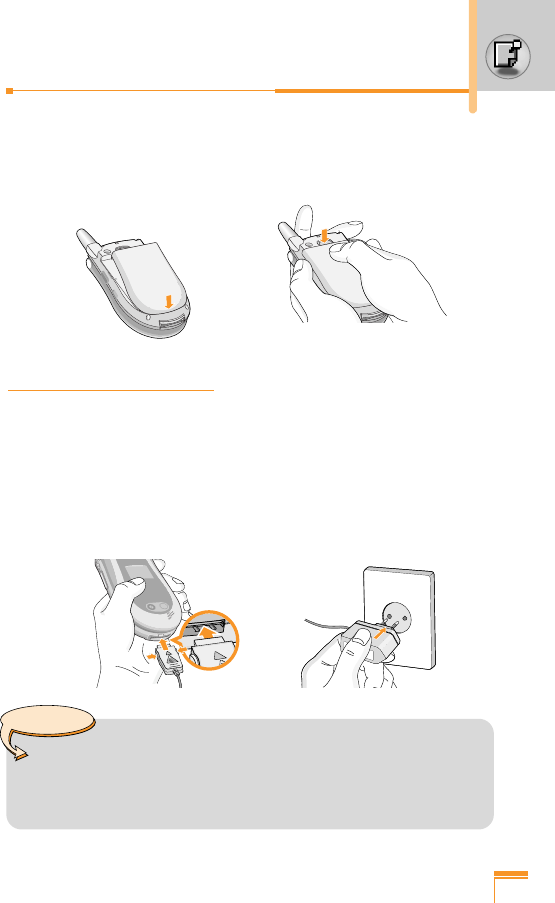
21
2. Position the lugs on the bottom of the battery into the retaining
holder. Then, push the top half of the battery into position until
the latch clicks
Charging the battery
Only use the mains adapter supplied with your phone.
1. With the battery in position on the phone, connect the lead from
the travel adapter to the bottom of the phone. Make sure that the
arrow on the lead connector is facing towards the front of the
phone.
2. Connect the other end of the adapter to the power outlet.
Caution
• Use of unauthorised accessories could damage your
phone and invalidate your warranty.
Do not force the connector as this may damage the
phone and/or the mains adapter.
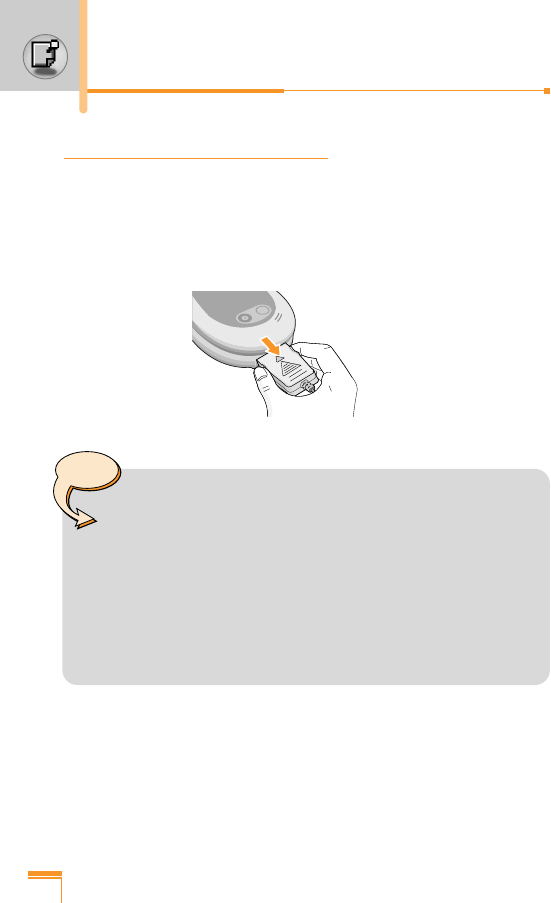
22
Disconnecting the adapter
1. When charging is finished, the moving bars of the battery icon
stop and ‘Full’ is displayed on the screen.
2. Unplug the adapter from the power outlet. Disconnect the
adapter from the phone by pressing the grey tabs on both sides
of the connector and pull the connector out.
Note
• Ensure the battery is fully charged before first using the
phone.
• Do not remove the battery or SIM card while charging.
• In the case the battery is not properly charged, please
turn the phone off and on using the power key, then
recharge the battery. After detaching and reattaching
the battery, please recharge the battery. After
detaching and reattaching the battery, please attempt
to recharge the battery.
Getting started
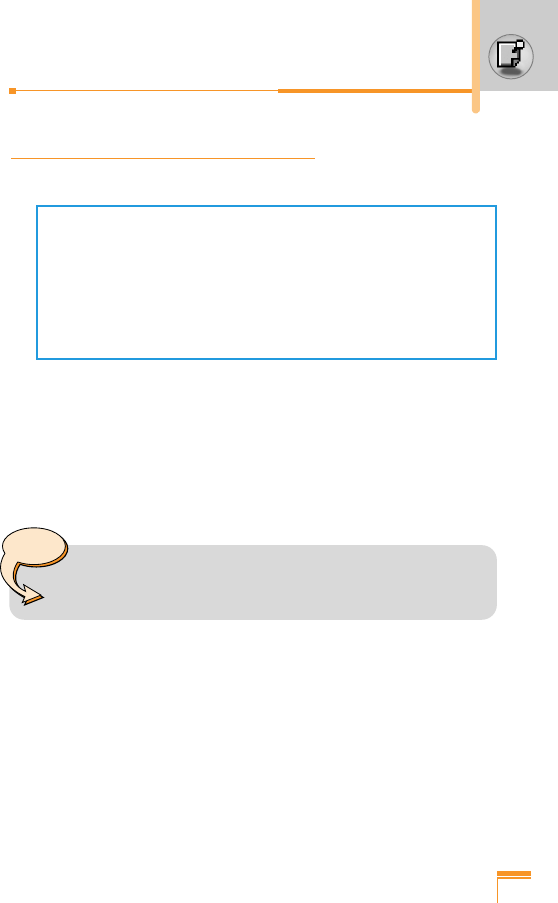
23
Turning your phone on and off
Turning your phone ON
1. Install a battery to the handset and connect the phone to an
external power source such as the travel adapter, cigarette
lighter adapter or hands-free car kit. Or install a charged battery
pack to the handset.
2. Press Efor a few seconds until the LCD screen is turned on.
3. Depending on the status of the PIN code request setting you
may need to enter your PIN code.
Turning your phone OFF
1. Press Efor a few seconds until the LCD screen is turned off.
Note
• Like any other radio devices, avoid any unnecessary
contact with the antenna while your phone is on.

24
Getting started
Access codes
You can use the access codes described in this section to avoid
unauthorised use of your phone. The access codes (except PUK
and PUK2 codes) can be changed by using the Change codes
feature [Menu 3-6-5].
PIN code (4 to 8 digits)
The PIN (Personal Identification Number) code protects your SIM
card against unauthorised use. The PIN code is usually supplied
with the SIM card. When the PIN code request is set to Enable,
your phone will request the PIN code every time the phone is
switched on. When the PIN code request is set to Disable, your
phone connects to the network directly without the PIN code.
PIN2 code (4 to 8 digits)
The PIN2 code, supplied with some SIM cards, is required to
access functions such as Advice of Call Charge and Fixed dial
number. These functions are only available if supported by your
SIM card. Check with your network for further information.
PUK code (4 to 8 digits)
The PUK (PIN Unblocking Key) code is required to change a
blocked PIN code. The PUK code may be supplied with the SIM
card. If not, contact your network operator for the code. If you lose
the code, also contact your network operator.
PUK2 code (4 to 8 digits)
The PUK2 code, supplied with some SIM cards, is required to
change a blocked PIN2 code. If you lose the code, also contact your
network operator.

25
Security code (4 to 8 digits)
The security code protects the unauthorised use of your phone.
The default security code is set to ‘0000’ and the security code is
required to delete all phone entries and to activate the Reset
settings menu. Also, the security code is required to enable or
disable the phone lock function to prevent unauthorised use of the
phone. The security code default setting can be modified from the
Security settings menu.
Barring password
The barring password is required when you use the Call barring
function. You obtain the password from your network operator when
you subscribe to this function. See page 84 for further details.

General functions
26
Making and answering calls
Making a call
1. Make sure your phone is switched on.
2. Enter a phone number, including the area code. To edit a
number on the LCD screen, press the right/left navigation keys to
move the cursor to the desired position or simply press the clear
key (C) to erase one digit at a time.
ᮣPress and hold the clear key (C) to erase the entire number.
3. Press the send key (S) to call the number.
4. To end the call, press the end key (E) or the right soft key.
You can also end the call by sliding the keypad up.
Making a call using the send key
1. In standby mode, press the send key (S), and the latest
incoming, outgoing and missed phone numbers will be displayed.
2. Select the desired number by using the up/down navigation key.
3. Press S.
Making an international call
1. Press and hold the 0 key for the international prefix. The ‘+’
character automatically selects the international access code.
2. Enter the country code, area code, and the phone number.
3. Press S.
Ending a call
When you have finished your call, press the end key (E).

27
Making a call from the address book
You can save the names and phone numbers dialled regularly in the
SIM card and/or phone memory, which is Address book. You can
dial a number by simply looking up the desired name in the Address
book. For further details on the Address book feature, please refer
to page 39-40.
Adjusting the volume
If you want to adjust the earpiece volume during a call, use the side
keys . Press the up side key to increase and down side key to
decrease the volume.
Answering a call
When you receive a call, the phone rings and the flashing phone
icon appears on the screen. If the caller can be identified, the
caller’s phone number (or name if saved in the address book) is
displayed.
1. To answer an incoming call, open the flip.
2. To end the call, closed the flip or press the E.
Manner mode (Quick)
You can activate the manner mode by pressing and holding down
one of the side keys ( ) in the state of sliding keypad up.
Note
ᮣYou can answer a call while using the Address book or
other menu features.

28
General functions
T9 mode
This mode lets you enter words with only one keystroke per
letter. Each key on the keypad has more than one letter. The
T9 mode automatically compares your keystrokes with an
internal dictionary to determine the correct word, thus requiring
far fewer keystrokes than the traditional ABC mode. This is
sometimes known as predictive text.
ABC mode
This mode lets you enter letters by pressing the key labelled
with the required letter once, twice, three or four times until the
letter is displayed.
123 mode (Number mode)
Type numbers using one keystroke per number. To change to
123 mode in a text entry field, press the # key until 123
mode is displayed.
Signal strength
You can check the strength of your signal by the signal indicator
( ) on the LCD screen of your phone. Signal strength can vary,
particularly inside buildings. Moving near to a window may improve
reception.
Entering text
You can enter alphanumeric characters by using the phone’s
keypad. For example, storing names in the address book, writing a
message, creating a personal greeting or scheduling events in the
calendar all require entering text.
The following text input methods are available in the phone.
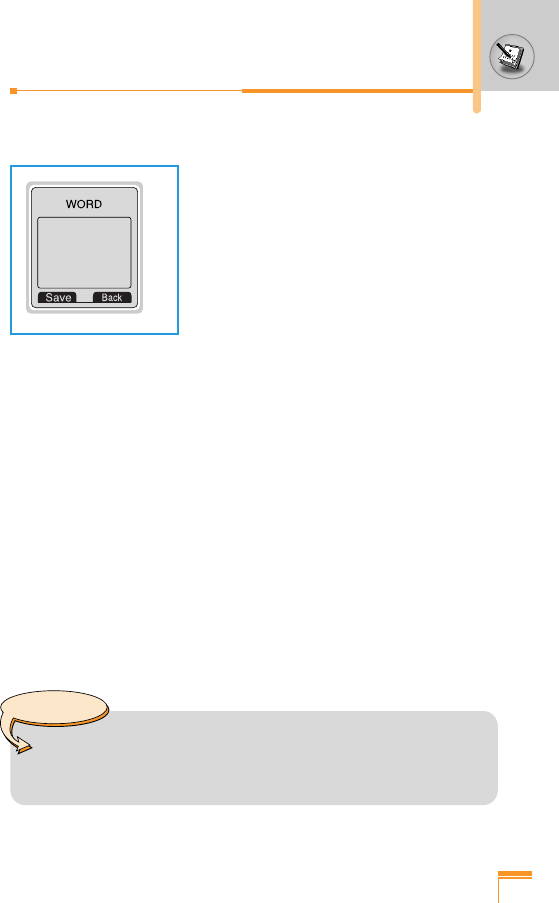
29
Changing the text input mode
1. When you are in a field that allows
characters to be entered, you will notice
the text input mode indicator in the lower
right corner of the LCD screen.
2. Change the text input mode by pressing
#. You can check the current text input
mode in the lower right corner of the LCD
screen.
ᮣ Using the T9 mode
The T9 predictive text input mode lets you enter words easily with a
minimum number of key presses. As you press each key, the phone
begins to display the characters that it thinks you are typing based
on the built-in dictionary. You can also add new words in the
dictionary. As new words are added, the word changes to reflect the
most likely candidate from the dictionary.
1. When you are in the T9 predictive text input mode, start entering
a word by pressing keys 2 to 9. Press one key per letter.
– The word changes as letters are typed. Ignore what’s on the
screen until the word is typed completely.
– If the word is still incorrect after typing completely, press the
down navigation key once or more to cycle through the other
word options.
Example
• Press 4 6 6 5 to type Good.
• Press 4 6 6 3 [Down navigation key] to
type Home.
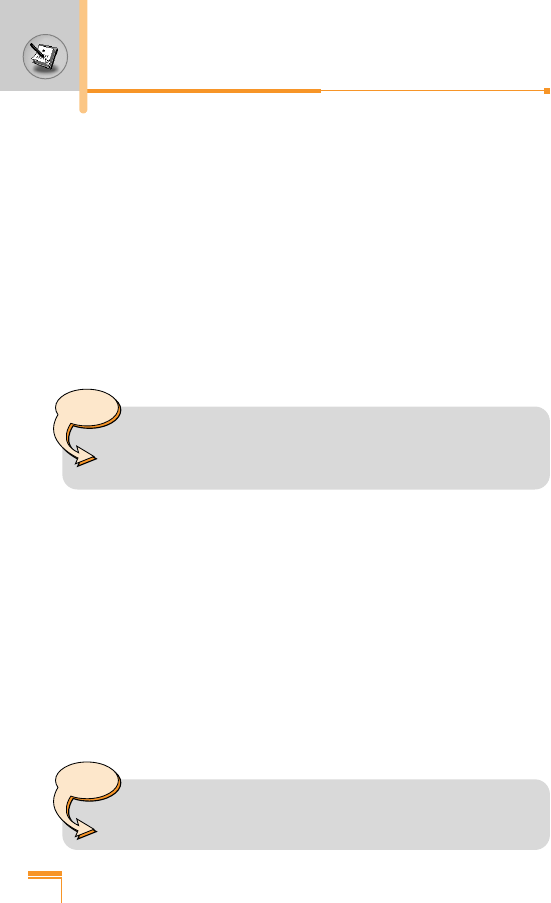
30
General functions
– If the desired word is missing from the word choice list, add it
using the ABC mode.
– You can select the language of the T9 mode. Press the left
soft key [Option], then select T9 languages. Select the
desired language of T9 mode. You can also turn off the T9
mode by selecting T9 off. The default setting on the phone is
T9 enabled mode.
2. Enter the whole word before editing or deleting any keystrokes.
3. Complete each word with a space by pressing the 0 key.
To delete letters, press C. Press and hold down to erase C
entire words.
ᮣ Using the ABC mode
Use the 2to 9 keys to enter your text.
1. Press the key labelled with the required letter:
– Once for the first letter
– Twice for the second letter
– And so on
2. To insert a space, press the 0 key once. To delete letters,
press the C key. Press and hold down the C key to clear
the whole display.
Note
• To exit from the text input mode without saving your
input, press E. The phone goes back to standby
mode.
Note
• Refer to the table below for more information on the
characters available using the alphanumeric keys.
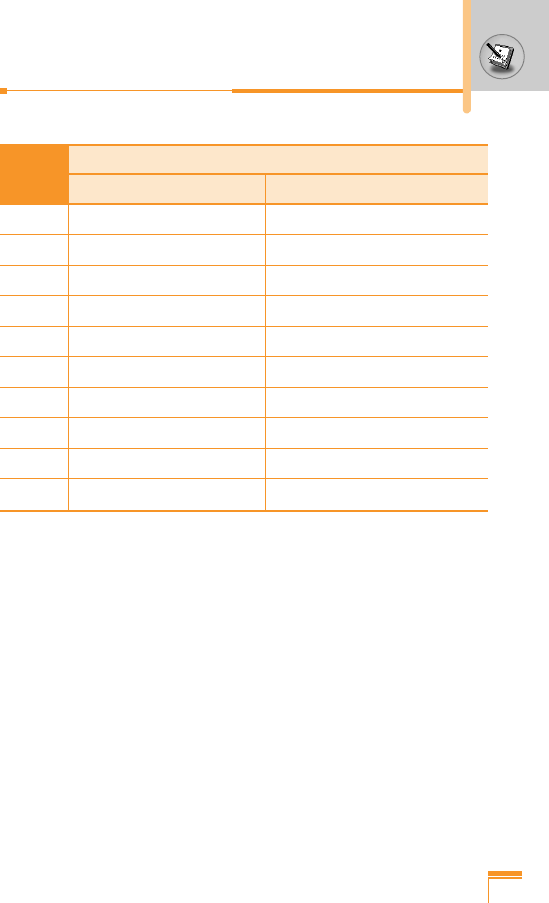
31
Key Characters in the order display
Upper case Lower case
1. , - ? ! ' @ : 1 . , - ? ! ' @ : 1
2A B C 2 a b c 2
3D E F 3 d e f 3
4G H I 4 g h i 4
5J K L 5 j k l 5
6M N O 6 m n o 6
7P Q R S 7 p q r s 7
8T U V 8 t u v 8
9W X Y Z 9 w x y z 9
0Space key Space key
ᮣ Using the 123 (Number) mode
The 123 mode enables you to enter numbers in a text message (a
telephone number, for example).
Press the keys corresponding to the required digits before manually
switching back to the appropriate text entry mode.

Address book
You can store phone numbers and their corresponding names in the
memory of your SIM card.
In addition, you can store up to 255 numbers and names in the
phone memory.
The SIM card and phone are both used in the same way in the
Address book menu. (Refer to page 39-44 for details.)
In-call menu
Your phone provides a number of control functions that you can use
during a call. To access these functions during a call, press the left
soft key [Options].
During a call
The menu displayed on the handset screen during a call is different
to the default main menu displayed when in standby mode, and the
options are described below.
Making a second call
You can get a number you wish to dial from the address book to
make a second call. Press the right soft key then select Search. To
save the dialled number into the address book during a call, press
the right soft key then select Add new.
Switching between two calls
To switch between two calls, press the left soft key then select
Swap.
32
General functions

Answering an incoming call
To answer an incoming call when the handset is ringing, simply
press the S key. The handset is also able to warn you of an
incoming call while you are already on a call. A tone sounds in the
earpiece, and the display will show that a second call is waiting.
This feature, known as Call waiting, is only available if your
network supports it. For details of how to activate and deactivate it
see Call waiting [Menu 3-3-4] on page 49.
If Call waiting is activated, you can put the first call on hold and
answer the second, by pressing Sor by selecting left soft key,
then Hold & Answer. You can end the current call and answer the
waiting call by selecting left soft key and then End & Answer.
Rejecting an incoming call
You can reject an incoming call without answering by simply
pressing the E key.
During a call, you can reject an incoming call by pressing the left
soft key [Menu] key and selecting the Conference/Reject or by
pressing the E.
Muting the microphone
You can mute the microphone during a call by pressing the [Menu]
key then selecting Mute on. The handset can be unmuted by
selecting Mute off. When the handset is muted, the caller cannot
hear you, but you can still hear them.
Switching DTMF tones on during a call
To turn DTMF tones on during a call, press the left soft key, and
then select DTMF on. DTMF tones can be turned off the same way.
DTMF tones allow your phone to make use of an automated
switchboard.
33

Multiparty or conference calls
The multiparty or conference service provides you with the ability to
have a simultaneous conversation with more than one caller, if your
network operator supports this feature. A multiparty call can only be
set up when you have one active call and one call on hold, both
calls having been answered. Once a multiparty call is set up, calls
can be added, disconnected or separated (that is, removed from the
multiparty call but still connected to you) by the person who set up
the multiparty call. These options are all available from the In-Call
menu. The maximum callers in a multiparty call are five. Once
started, you are in control of the multiparty call, and only you can
add callers to the multiparty call.
Making a second call
You can make a second call while currently on a call. Enter the
second number and press the S key. When the second call is
connected, the first call is automatically placed on hold. You can
swap between calls by pressing the left soft key then selecting
Swap.
Setting up a conference call
Place one call on hold and while the active call is on, press the left
soft key and then select the Conference/Join all.
Putting a conference call on hold
Press the left soft key, then select the Conference/Hold all.
Activate the conference call on hold
Press the left soft key, then select the Conference/Join all.
34
General functions

Adding calls to the conference call
To add a call to an existing conference call, press the left soft key,
then select the Conference/Join all.
Displaying callers in a conference call
To scroll through the numbers of the callers who make up a
conference call on the handset screen, use the up/down navigation
keys.
Taking a private call during a conference call
To have a private call with one caller from a conference call, display
the number of the caller you wish to talk to on the screen, then
press the left soft key. Select the Conference/Private to put all the
other callers on hold.
Ending a conference call
The currently displayed caller from a conference call can be
disconnected by pressing the E key. To end a conference call,
press the left soft key, then select the Conference/End multiparty.
After pressing the left soft key, selecting Conference/End all will
end all the active and on-hold calls.
35
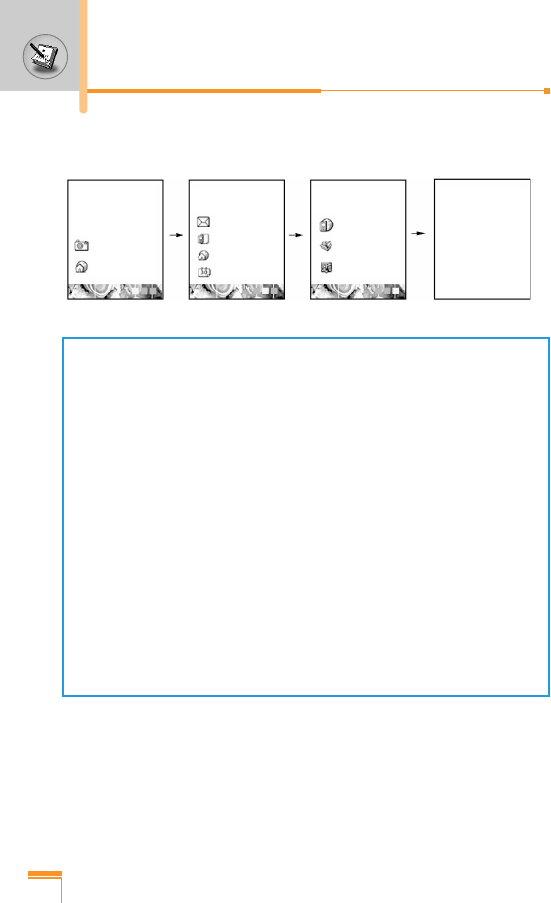
36
General functions
Startup Wizard
welcome get started top tips see again?
Get started with Orange
straight away.
Instant access when you need it.
Send and receive text and
photo messages.
Keep track of your calls.
Connect to Orange World.
Manage your times.
In the main menu press;
to access great online
to play games and
use other applications.
to check your photos,
videos and ring tones.
content from Orange.
Press:
to launch the camera.
to connect to
Orange World.
Will you see start up
wizard again?
Yes No
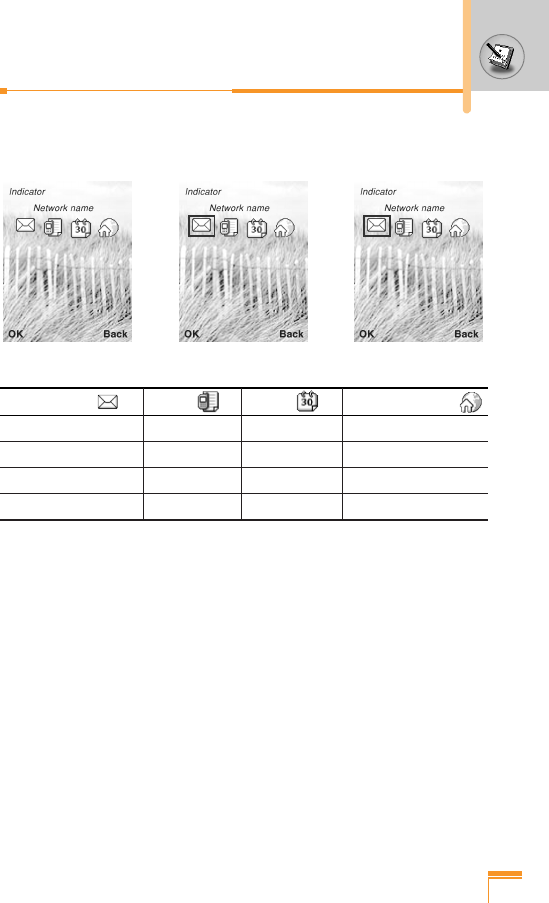
Homescreen Aggregator
• Homescreen/idle
- IDLE STATE
The idle state displays the four homecreen icons with no
selectable items listed. Moving up or down takes the user to the
(bottom or top of) address book. Moving right or left selects the
first (or last) of the icons, and displays a list of selectable items
(homescreen state).
- HOMESCREEN STATE
The homescreen state displays the four homescreen icons with
one selected, and a list of navigable items displayed. Moving up
or down navigates up or down the list of selectable items.
Moving right or left navigates through the 4 homescreen icons.
The phone reverts to idle state if the handset is closed and
opened, if the clear button is pressed, or if the red key is
pressed.
37
➝➝
Thu 01 Jan
00 : 01
Text msg.(1)
Picture msg.
Answer phone
Text msg.(1)
Picture msg.
Answer phone
HOMESCREEN ITEMS
messages calls diary Orange world
Text msg. (3) Missed(3) Calendar Orange world
Picture msg. (1) Received Memo Your page
Answer phone Dialled Channel guide
Delete all
L R U D

Call register
You can check the record of missed, received, and dialled calls only
if the network supports Calling Line Identification (CLI) within the
service area.
The number and name (if available) are displayed together with the
date and time at which the call was made. You can also view call
times and costs.
Press the send key (<) for a long time to enter Call register menu.
Missed calls
This option lets you view the last 10 unanswered calls. After
pressing the left soft key [Option], you can also:
• View the number if available and call it or save it in the address
book.
• Enter a new name for the number and save in the address book.
• Send a message to this number.
• Delete the call from the list.
Received calls
This option lets you view the last 10 incoming calls. After pressing
the left soft key [Option], you can also:
• View the number if available and call it or save it in the address
book.
• Enter a new name for the number and save in the address book.
• Send a message to this number.
• Delete the call from the list.
38
General functions
Note
• You can delete all the call records from the list using
the Delete recent calls menu.
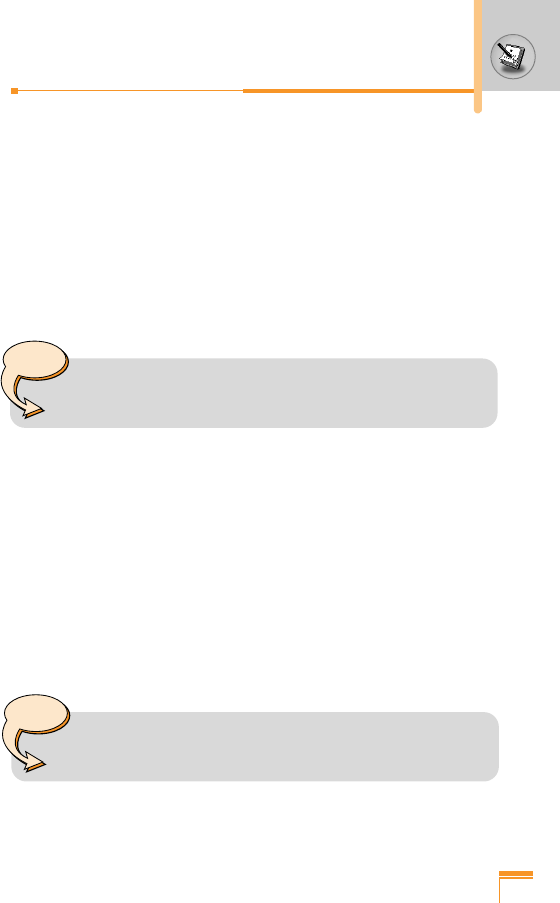
Dialled calls
This option lets you view the last 10 outgoing calls (called or
attempted). Using the [Option] key, you can also:
• View the number if available and call it or save it in the address
book.
• Enter a new name for the number and save in the address book.
• Send a message to this number.
• Delete the call from the list.
Delete recent calls
Use this to delete the missed call list, received call list, or dialled call
list. You can also delete all call lists at a time selecting All calls.
Call durations
Use this to view the duration of your incoming and outgoing calls.
You can check each call duration at the bottom of screen while
scrolling using the up/down navigation keys. Pressing the [OK] key
or the left soft key [Reset] resets the call timer of selected call. To
prevent accidental reset, you are requested to enter the PIN2 code.
39
Note
• You can delete all the call records from the list using
the Delete recent calls menu.
Note
• You can delete all the call records from the list using
the Delete recent calls menu.
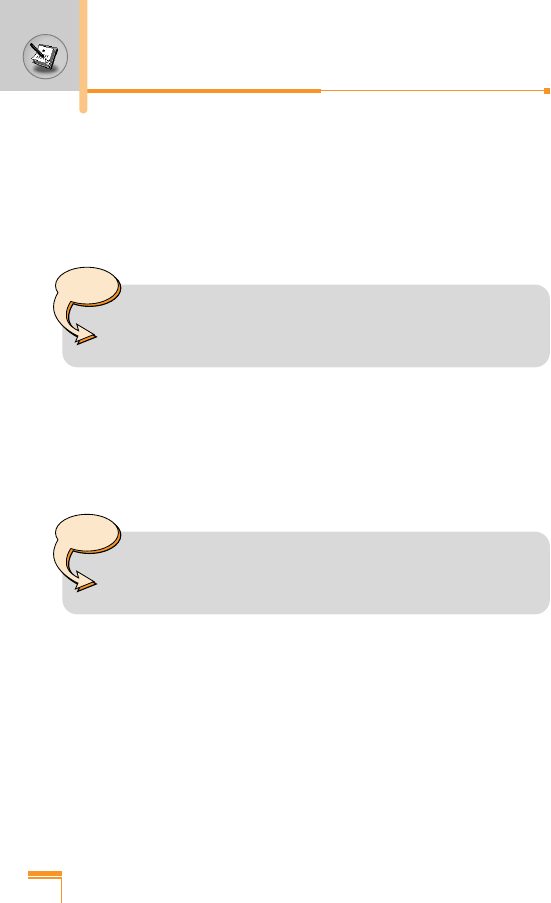
• Last call: Length of the last call
• Received calls: Length of the incoming calls
• Dialled Calls: Length of the outgoing calls
• All calls: Total length of all calls made or received calls since the
timer was last reset.
Call costs
This network service allows you to check the last call cost and the
total call cost. The call cost is displayed on the bottom of the LCD
screen. To reset the call cost, press the left soft key [Reset] or the
OK key. You are requested to enter the PIN2 code.
Cost settings
• Call cost’s limit: This network service allows you to limit the cost
of your calls to the number of charging units or units of currency.
You can make or receive a call up to the specified cost limit. You
can change the call cost’s limit after entering the PIN2 code.
• Set tariff: You can set the currency type and the unit price.
Contact your service providers to obtain charging unit prices. To
select the Currency or 1 Unit in this menu, you need the PIN2
code.
40
General functions
Note
• The actual time invoiced for calls by your service
provide may vary, depending on network features,
rounding-off for billing, etc.
Note
• The actual cost invoiced for calls by your service
provider may vary, depending on network features,
rounding-off for billing, taxes, etc.

• Auto display: This network service allows you to see
automatically the cost of your last call. If you select On in Auto
display menu, you can see the cost of the last call when the call
is released.
GPRS information
You can check the amount of data transferred over the network
through the GPRS information option. In addition, you can also
view how much time you are online.
(GPRS stands for General Packet Radio Service.)
• WAP
You can check the data volume and the time spent using WAP.
On the selected menu, pressing the left soft key [Reset] or the OK
key clears the counter.
• External device
You can check the data volume and the time spent using GPRS
with an external device such as a serial port.
• Total data
You can check the total amount of data through WAP and the
external device.
41
Note
• When all units have been used, no calls can be made
except emergency calls. Depending on the SIM card,
you need the PIN2 code to set a call cost limit.
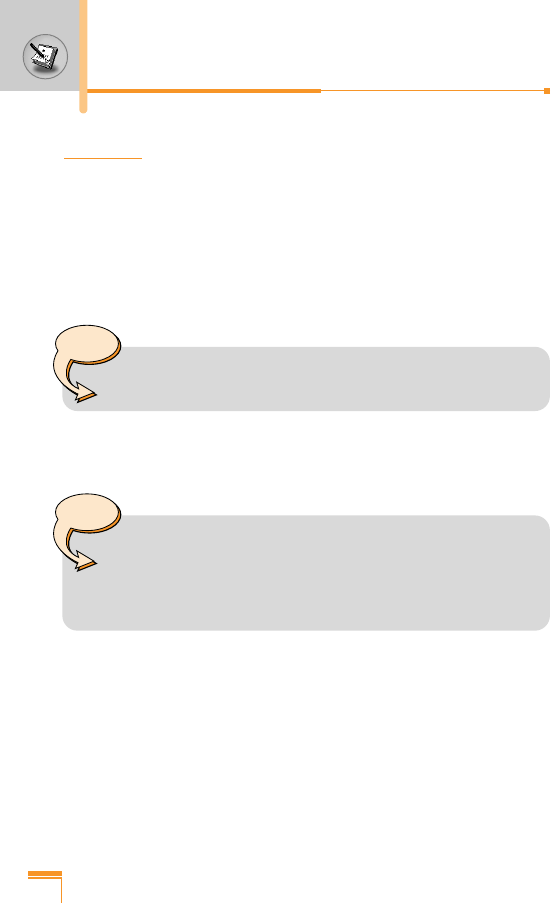
Camera
The L1100 has a built-in camera. It supports Zoom, White balance,
Colour/Sepia/Grey settings, and Multi burst functions.
Take picture
Press the camera key (Q) in standby mode.
1. Focus on the subject to capture, then press the [OK] key or the
down side key or camera hot key.
2. ‘Saved’ is displayed in the top left of the captured image. The
captured image is then automatically saved.
3. Press the [OK] key to continue taking pictures. Or press the right
soft key [Delete] to delete the image.
42
General functions
Note
• The remaining memory is shown in the top right of the
image. If there is insufficient memory, the image size is
automatically reduced. If the memory is full, ‘memory
full’ is displayed and you cannot take any more picture.
Create space by deleting old images.
Note
• In the preview mode, you can immediately go to Gallery
by pressing the right soft key [Gallery].
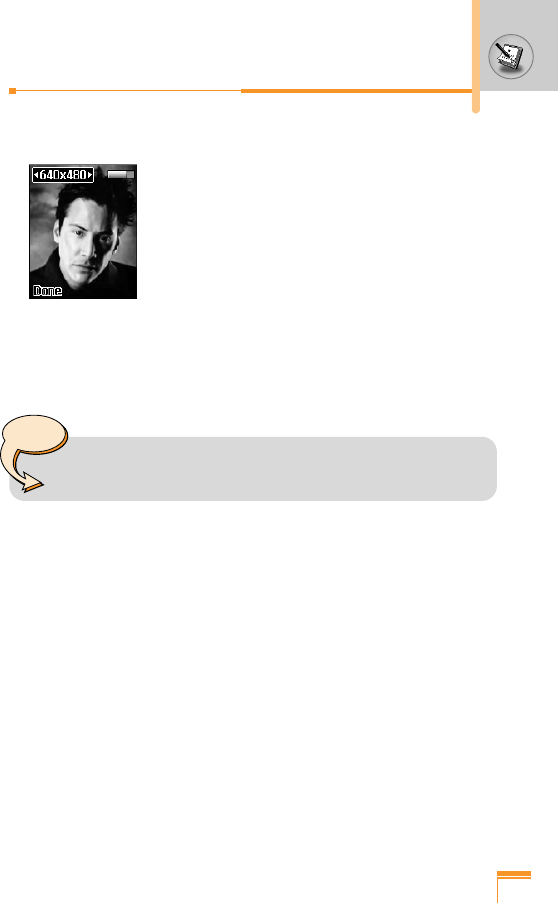
< Options before taking a picture >
Press the left soft key [Options] to set the
options in the preview mode. You can select the
desired option by pressing the [OK]. And you
will see the current option setting value in the
top left of the preview screen.
Then you can modify the desired value by pressing the left/right
navigation keys. If you press the [OK] or left soft key [Done], the
selected option value is set and return to the preview mode.
You can set the following options.
1. Image size: Select the desired image size to be captured.
[640x480, 320x240, 160x1120, 128x160, 48x80]
2. Brightness: Select the desired brightness. [-2 ~ +2]
3. White balance: Select the desired white balance.
[Auto/ Daylight/ Incandescent/ Cloudy/ Fluorescent ]
4. Zoom: Select the zoom factor [x1, x2, x4]
5. Colour effect: Select Colour/Sepia/Mono mode by using the
left/right navigation keys.
6. Multi burst: Select the number of images to be captured in multi
burst mode.
7. Shutter sound: Select shutter sound.
8. Defer settings: Return to the default factory settings.
43
Note
• The larger the image size, the better the image quality.
However, this will use more memory.

Gallery
Then select image category.
[All pictures / General pictures / Address book pictures]
You can view, organise and send pictures saved in your phone.
1. Use the navigation keys to select the picture you want a full
screen view of.
2. Press the [OK] key. You will see the name of the image on top of
the LCD screen.
3. Press the left soft key [Options] to access the following
submenus.
• Thumbnail/Enlarge: You can view the selected image.
• Send via MMS: Sends MMS picture messages using the
selected image. See page( ) about writing MMS message.
• Set as wallpaper: Set the selected image as wallpaper.
• Slide show: Plays back every image in the selected category
in succession, in order. To stop the slide show playback, press
the C key.
• Rename: You can change the title of the selected image.
• Delete: Deletes the selected image.
• Delete all:
Deletes all images in the selected category.
•
Picture information
: You can check the title, size, date and
time of the selected image.
4. To go back to the Camera menu, press the right soft key [Back].
Memory Status
You can check the memory status in your phone.
[total size/used size/free size]
44
General functions
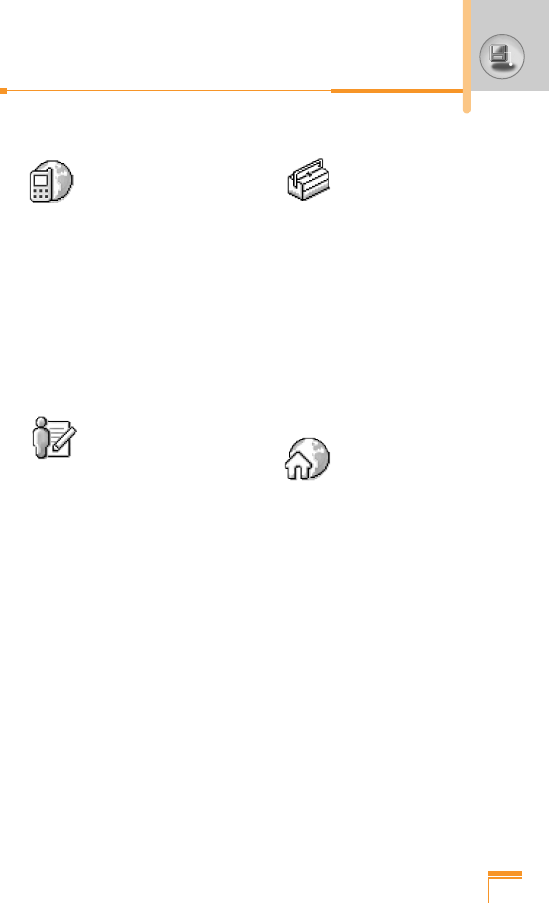
45
1 Broswer
1 Home
2 Bookmarks
3 Go to URL
4 Service messages
5 Cache settings
6 Account settings
7 Security
2 Profiles
1 Vibrate only
2 Silent
3 General
4 Outdoor
5 Headset
6 Car
3 Extras
1 Calendar
2 Memo
3 Alarm clock
4 Voice recorder
5 Calculator
6 Unit converter
7 World time
8 Activate IrDA
4 Orange World
1 Orange World
2 Your page
3 Channel guide
4 Your phone
5 Orange PLUS
Menu tree

46
5 Messages
1 Text message
2 Picture message
3 Answer phone
4 Info services
5 Templates
6 Memory status
6 Media album
1 Picture
2 Animation
3 Sound
4 Memory status
7 Apps & Games
1 Applications
2 Games
3 Download
4 Information
8 Address book
1 Search
2 Add new
3 Speed dials
4 Voice list
5 Caller groups
6 Copy all
7 Delete all
8 Settings
9 Information
9 Settings
1 Date & Time
2 Display settings
3 Call settings
4 Network settings
5 GPRS settings
6 Security settings
7 Reset settings
Menu tree
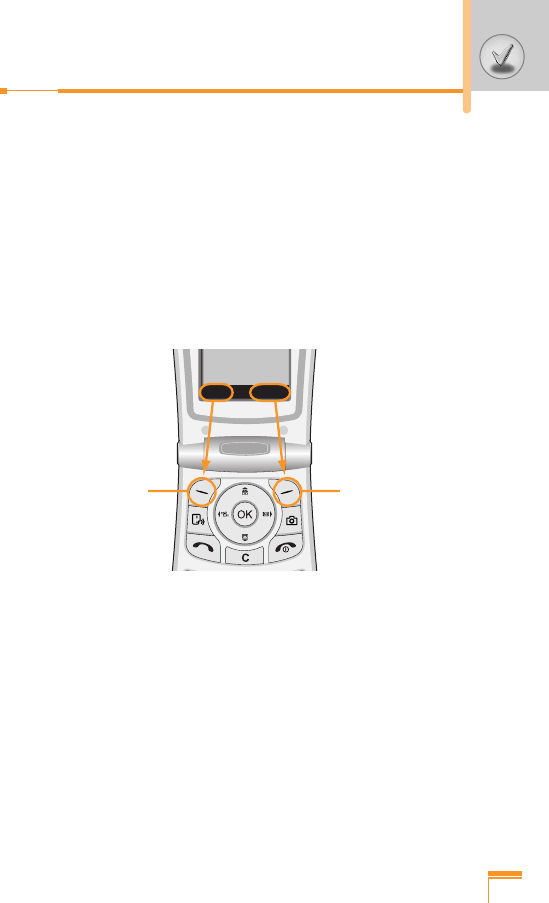
47
Your phone offers a set of functions that allow you to customise the
phone. These functions are arranged in menus and sub-menus,
accessed via the two soft keys marked <and >. Each menu
and sub-menu lets you view and alter the settings of a particular
function.
The roles of the soft keys vary according to the current context; the
label on the bottom line of the screen just above each key indicates
its current role.
Menu Names
Press the left soft
key to access the
available menu.
Press the right soft
key to activate the
corresponding
action.
Selecting functions and options

48
Broswer [Menu 1]
Press the Menu key <and select Broswer using navigation keys.
You can access various WAP (Wireless Application Protocol)
services such as banking, news, weather reports and flight
information. These services are specially designed for mobile
phones and they are maintained by WAP service providers.
Check the availability of WAP services, pricing and tariffs with your
network operator and/or the service provider whose service you
wish to use. Service providers will also give you instructions on how
to use their services.
Please contact your network operator to open your Internet account.
To use the Web Browser, you must indicate your phone number via
the Own number menu option (See page 44 for further details.).
Once connected, the homepage is displayed. The content depends
on the service provider.
You can access any website page by entering its URL address. To
exit the browser at any time, press the E key. The phone will
return to the standby mode.
Navigating with the WAP browser
You can surf the Internet using either the phone keys or the WAP
browser menu.
Using the phone keys
When surfing the Internet, the phone keys function differently to
phone mode.
Key Description
U D Scrolls each line of the content area
CReturns to the previous page
OSelects options and confirms actions

49
Using the WAP browser menu
There are various menu options available when surfing the Wireless
Web.
Home [Menu 1-1]
Connect to a homepage. The homepage will be the site which is
defined in the activated profile. It will be defined by the service
provider if you have not defined it in the activated profile.
Bookmarks [Menu 1-2]
Set the current page as a new bookmark or move an established
bookmark. Your phone may have some pre-installed bookmarks for
sites not affiliated with LG. LG does not warrant or endorse these
sites. If you choose to access them, you should use the same
security or content precautions as you would with any site.
E-mail server [Menu 1-2-1]
• Connect
Connects to the E-mail server that you configured.
• Edit address
Edit the E-mail address.
Go to URL [Menu 1-3]
You can connect directly to the site you want. To do this, you need
to enter a specific URL.
Note
• The WAP browser menus may vary, depending on your
browser version.

50
Broswer [Menu 1]
Service messages [Menu 1-4]
Inbox [Menu 1-4-1]
You can order Push messages from WAP service providers. Push
messages are notifications of, for example, news headlines and
they can contain a text message or the address of a WAP service.
For availability and subscription, contact your WAP service provider.
Service providers can update an existing Push message every time
a new Push message is received. Messages can be updated even if
you have moved them to another folder. When Push messages
expire, they are deleted automatically.
• Information
Shows the information of received push messages.
• Load
Connects to a specific site using the information in the received
push message.
• Delete
Deletes the selected push message.
Receive [Menu 1-4-2]
You can choose whether or not you wish to receive push messages.
Cache settings [Menu 1-5]
The information or services you have accessed are saved in the
cache memory of the phone.
• Clear cache
Removes all context saved in cache.
• Check cache
Set a value whether a connection attempt is made through cache
or not.
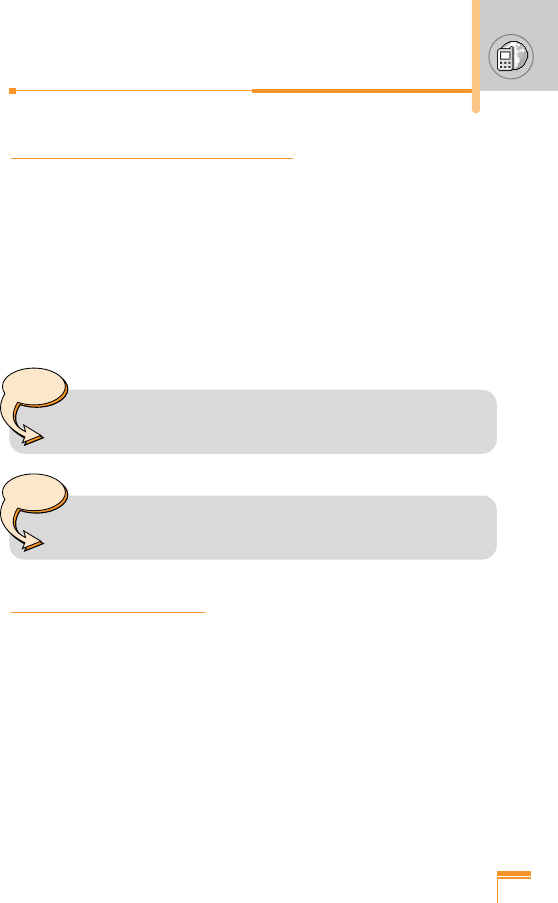
51
Account settings [Menu 1-6]
For more information, consult your network operator.
Each profile has submenus as follows:
• Activate: Activates the selected profile.
• Settings: Use this to edit and change WAP settings for the
selected profile.
• Rename: You can change the selected profile’s name.
• Delete: Deletes the selected profile from the list.
• Add new: You can add a new profile.
Security [Menu 1-7]
A list of the available certificates is shown.
Note
• The changes using these options may affect the MMS
function.
Note
• A cache is a buffer memory, which is used to save data
temporarily.

52
Profiles [Menu 2]
In Profiles, you can adjust and customise the phone tones for
different events, environments, or caller groups.
There are six preset profiles: Vibrate Only, Silent, General,
Outdoor, Headset and Car. Each profile can be personalised.
Press the Menu key (<) and select Profiles using navigation
keys.
Changing the profile [Menu 2-x-1]
1. A list of profiles is displayed.
2. In the Profile list, scroll to the profile you want to activate and
press the left soft key [Select] or OK key.
3. Then, select Activate.
Customising profiles – Personalise [Menu 2-x-2]
Scroll to the desired profile in the Profile list. After pressing the OK
key or the left soft key, select Personalise. The profile setting
option opens. Set the option as required.
Incoming call alert: Set the alert type for incoming calls.
Ringing tone: Select the desired ring tone from the list. Scroll
through the list using up/down navigation keys. You can hear the
desired tone prior to making a selection.
Ringing volume: Set the volume of the ringing tone.
Message alert type: Set the alert type for messages.
Message alert tone: Select the alert tone for messages.
Keypad tone: Select the desired keypad tone.
Key volume: Set the volume of keypad tone.
Flip tone: Set the flip tone for flip open and close.
Effect sound volume: Set the volume of effect sound.
Power on/off volume: Set the volume of the ringing tone when
switching the phone on/off.

53
Automatic answer: (only in Headset profile and Car profile) You
can activate the automatic answer feature. Select the time before
answering automatically.
Customising profiles – Rename [Menu 2-x-3]
You can rename a profile and give it any name you want. Vibrate
only, Headset and Car profiles cannot be renamed.
1. To change the name of a profile, scroll to the profile in the profile
list and after pressing the OK key or the left soft key, select
Rename.
2. Key in the desired name and press the OK key or the left soft key
[Save].

Press the Menu key (<) and select Extras using navigation keys.
Calendar [Menu 3-1]
When you enter this menu, a calendar appears. A square cursor is
located on the current date. You can move to another date using
navigation keys. If a date is shown in a different colour, it means
that there is a schedule or memo for that day. This function reminds
you of your schedule and memos. The phone will sound an alarm
tone if you set the phone to do so.
View [Menu 3-1-1]
Shows the note for the chosen day. Press [Options] to delete or edit
the note you selected.
Edit [Menu 3-1-2]
Use this to edit the schedule.
Delete [Menu 3-1-3]
Use this to delete the schedule.
Add new [Menu 3-1-4]
You can edit a maximum of 30 characters and take up to 20 notes.
Calendar [Menu 3-1-5]
Goes back to the calendar.
Scheduler tone [Menu 3-1-6]
The phone can sound an alarm tone when the scheduled date and
time for an event has been reached with this option.
View all schedules [Menu 3-1-7]
Shows the notes that are set for all days. Use the up/down
navigation keys to browse through the note lists.
54
Extras [Menu 3]

Go to date [Menu 3-1-8]
Use this to jump to a specific date. Enter the date using the numeric
keys and the left/right navigation keys.
Delete past [Menu 3-1-9]
You can delete expired schedule notes that have already been
notified.
Delete all [Menu 3-1-10]
Use this to delete all schedules. You are asked to confirm this
action.
Memo [Menu 3-2]
You can write, edit and delete a memo on a specific date.
1. Scroll to highlight Memo.
2. Press the left soft key [Add].
3. Input the memo and then press the left soft key [Options].
The following options are available.
• Save: Allows you to save the memo.
• T9 languages: Select the desired language of T9 mode.
• Exit editor: Allows you to exit from the memo editor.
After a memo is already input in your phone,
1. Select a memo.
2. Press the left soft key [Select].
3. Press the left soft key [Options].
The following options are available.
• Edit: You can edit the selected memo.
• Delete: Deletes the selected memo.
• Add new: You can add new meno.
• Delete all: Deletes all meno.
55

56
Extras [Menu 3]
Alarm clock [Menu 3-3]
Set the alarm to ring at a specific time. In the Alarm Clock menu,
the following options are available.
On [Menu 3-3-1]
Set the alarm time.
1. Enter the menu.
2. Select [On] by the left/right navigation key.
3. Enter the alarm time using the numeric keys.
4. Using the left/right navigation keys, select one of the alarm
options: Once, Daily, Weekly, and Monthly.
5. Alarm melody section: select the desired alarm melody using the
left/right navigation keys.
Off [Menu 3-3-2]
Deactivates the alarm.
Voice recorder [Menu 3-4]
You can record a memo. You can record up to 3 voice memos up to
a maximum of 30 seconds each. You can play or delete the
recorded memo or record new voice memo using the left soft key
[Option] key.
Record [Menu 3-4-1]
1. Press and hold down key in standby mode.
2. Once recording is started, the message ‘Recording...’ and the
remaining time is displayed.
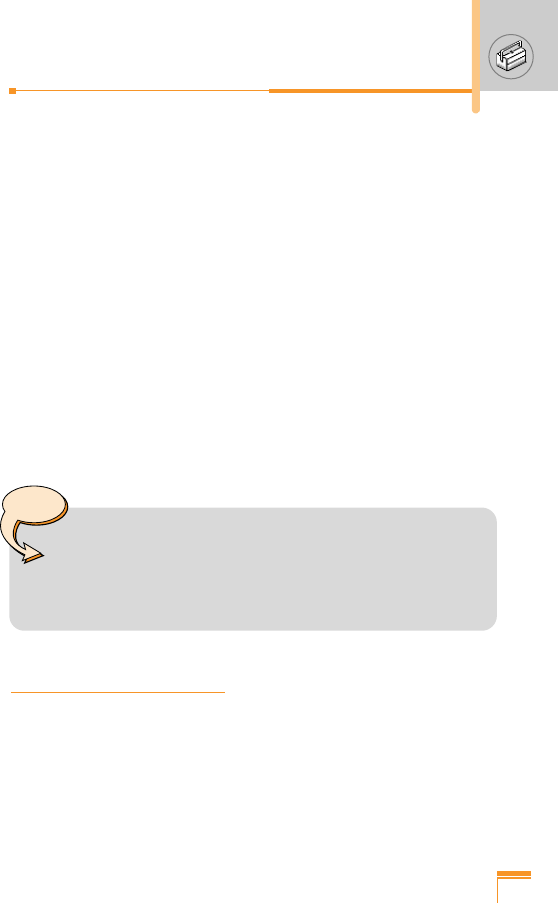
57
3. When you finish recording, press left soft key [Save].
• Play: Allows you to play back all memos recorded, starting with
the most recent memo. The screen displays the Date and time
when the memo was recorded.
• Delete: Allows you to delete a specific memo.
• Record new: Allows you to record a memo.
• Send via multimedia message: Allows you to send via
multimedia message.
• Delete all: Allows you to delete all memos. Press the left soft
key [Yes] to confirm.
View list [Menu 3-4-2]
The phone shows the voice memo title which you have recorded by
pressing in standby mode. You can Play, or Delete the recorded
voice memo.
Calculator [Menu 3-5]
Using this feature, you can use the phone as a calculator. The
calculator provides the basic arithmetic functions: addition,
subtraction, multiplication and division. (You can enter numbers up
to the second decimal place)
Note
• In standby mode, you can go directly to the Voice
recorder menu by pressing the down navigation key.
• If all memo locations are full, you must delete an old
memo before recording a new one.

58
Extras [Menu 3]
Using the calculator [Menu 3-5-1]
1. Enter the first number using the numeric keys.
2. Press the corresponding navigation key to select a mathematical
function.
3. To calculate the result, press the left soft key [Result] or OK key.
4. After calculation, press the left soft key [Reset] to return to the
initial state.
Unit converter [Menu 3-6]
This converts any measurement from one unit to another. There are
4 types that can be converted into units: Length, Surface, Weight
and Volume.
1. Select one of four unit types by pressing the left soft key [Unit].
2. Move to the current unit section by pressing the down navigation
key.
3. Select the unit you want to convert using the left/right navigation
keys.
4. Move to the Convert unit section by pressing the down navigation
key.
5. Select the unit you want to convert to, using the left/right
navigation keys.
6. Input numbers using the numeric keys. Conversion is calculated
automatically.
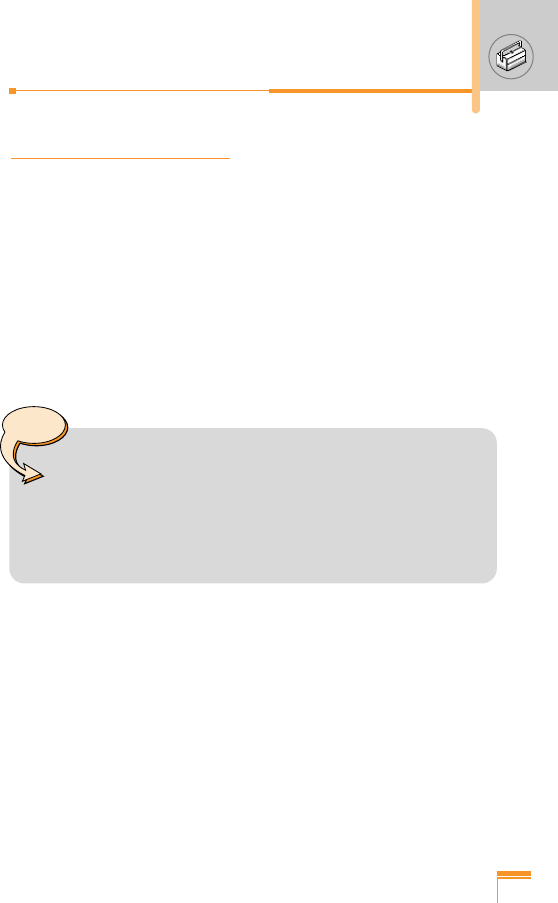
59
World time [Menu 3-7]
You can check the current time of Greenwich Mean Time (GMT)
and 58 major cities around the world, using the left/right navigation
keys.
The screen shows the city name, current date and time. To select
the time zone in which you are located, proceed as follows:
1. Select the city corresponding to your time zone by pressing the
left/right navigation keys one or more times. The local date and
time are displayed.
2. If you want to change the time display in standby mode to the
selected time, press the left soft key [Options]. And select Set.
Note
• You can input a decimal number by pressing the key.
• To erase any mistakes and clear the display, press the
key. To include a decimal point, press the key.
To include a minus sign, press the key.
• The time zone setting of each city in World time menu
may be affected by network condition.

60
Extras [Menu 3]
Activate IrDA [Menu 3-8]
This feature allows you to send or receive data/fax through the
infrared port. To use an infrared connection:
1. Install the modem driver for receiving or sending the data/fax.
2. Install the network dial-up software supplied by your network
provider or fax application program for a fax call on your PC.
3. Configure and activate an IrDA-compliant infrared port on your
PC.
4. Activate the infrared feature on the phone; the symbol appears on
the right side at the bottom of the display.
5. Call the network service number given to you by the service
provider.
If there is no communication between your phone and the IrDA-
compliant device within 30 seconds of activation of the feature, it is
automatically deactivated.
For further details, contact your network provider.
Note
• PC Sync is a program for data exchange between PC
and the phone by a data cable. Therefore, if you want
to use this function, you need to buy the accessory kit.
For more information, you can use the PC Sync Help
file on the CD.
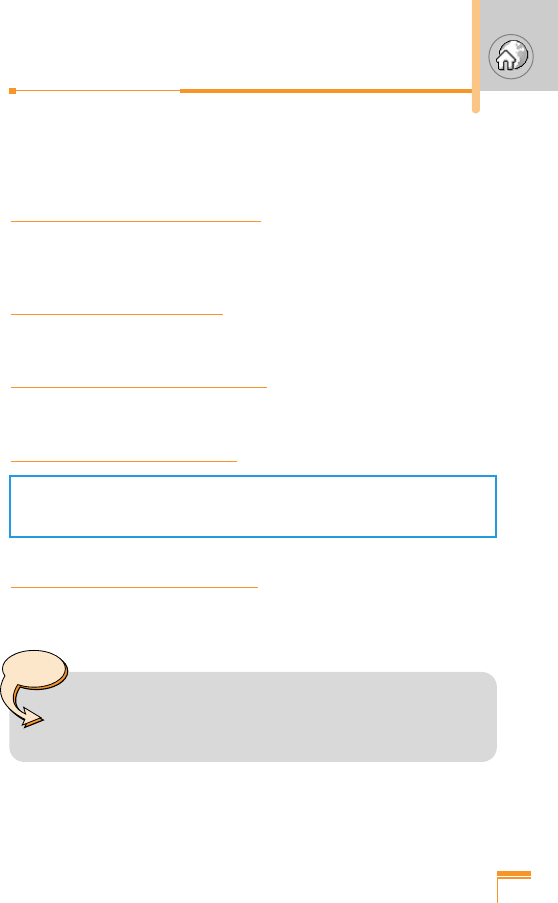
61
Orange World [Menu 4]
The phone supports services based on Wireless Application
Protocal (WAP).
Orange World [Menu 4-1]
This menu allows you to connect directly in the WAP Orange
world.
Your page [Menu 4-2]
You can access directly your page on the WAP from this menu.
Channel guide [Menu 4-3]
You can access directly Channel on the WAP from this menu.
Your phone [Menu 4-4]
Orange PLUS [Menu 4-5]
All the services of sim application toolit (SAT) are available in this
menu.
Note
• To know the prices for all these services, consult the
Orange current tariff or contact your customer
engineering.

62
Press the Menu key (<) and select Messages using navigation
keys.
Text message [Menu 5-1]
Your phone receives voice mail notification messages and Short
Message Service (SMS) messages.
Voice mail and SMS are network services. Please contact your
network operator for more information.
When the icon appears, you have received voice mail.
When the icon appears, you have received a new text message.
If the message memory is full, a message is displayed, the icon
flashes and you cannot receive any new messages. Use the Delete
option in the Inbox menu to delete obsolete messages.
Once there is space in the message memory, any undelivered SMS
messages will be received (provided sufficient space is available).
Write message [Menu 5-1-1]
You can write and edit text messages up to 6 pages.
(approximately 918 characters)
1. Key in your message. For details on how to enter text, refer to
page 23 through 27 (Entering Text).
2. After you complete the message, to select the required option,
press the left soft key [Option].
The following options are available.
• Send to number: Enter the number or select the number from
the address book or the recent numbers. You can send a
message up to 5 phone numbers at a time. Press the left soft
key [Options]. The following options will be displayed.
– Send (It only shows after a phone number is entered)
– Recent numbers
– Search
Messages [Menu 5]

63
• Save to draft: Allows you to save the message so that it can
be sent later.
• T9 languages: Select the desired language of T9 mode.
• Clear text: Erases the whole text.
• Exit: Allows you to exit from the Write message menu.
3. You can also send attachments with the message by pressing
the right soft key [Attach], while you’re entering a message.
• Symbol: You can attach special characters.
• Picture: You can send and receive text messages that contain
pictures, known as ‘picture messages’. Several preset pictures
are available in the phone and they can be replaced with new
ones received from other sources.
• Animation: Attaching an animation in a message can be done
through EMS (Enhanced Messaging Service). You can select
any of 15 animations in the phone.
• Sound: If available, you can attach a sound available for a
short message.
• Text template: You can use text templates already set in the
phone.
• Phone number: You can add phone numbers in the message.
• Singnature: You can attach your singnature.
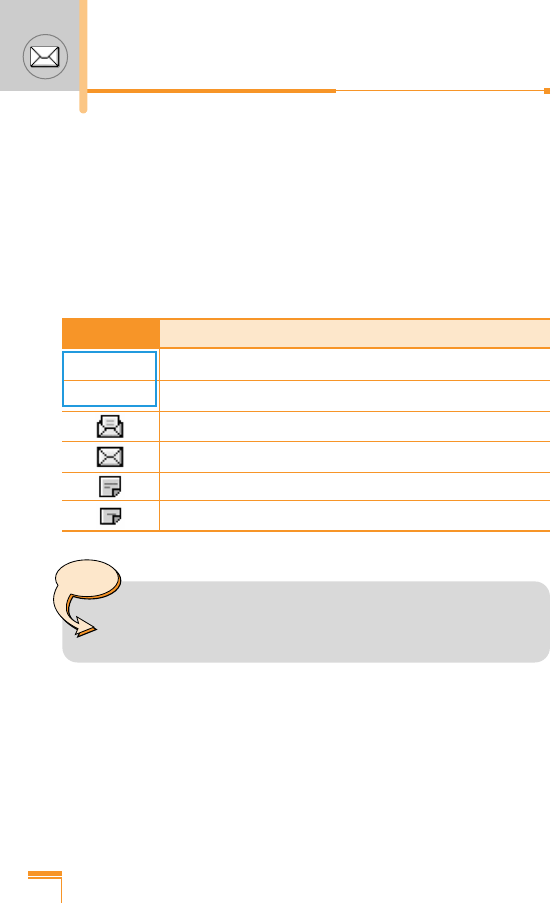
64
Messages [Menu 5]
Inbox [Menu 5-1-2]
Received messages can be searched and the contents can be
viewed.
Received messages are displayed in date order.
Press the menu key and select Messages ➞Text messages ➞
Inbox.
Or, you can use home screen aggregator to enter Inbox.
Each received message has the following options available.
Press the left soft key [Options].
• Reply
Replies to the received message.
Note
• SIM message refers the message saved in the SIM
memory. And the network distinguishes an incoming
message into the SIM message or just message.
Icon Description
Read SIM message
Unread SIM message
Read message
Unread message
Read delivery report
Unread delivery report
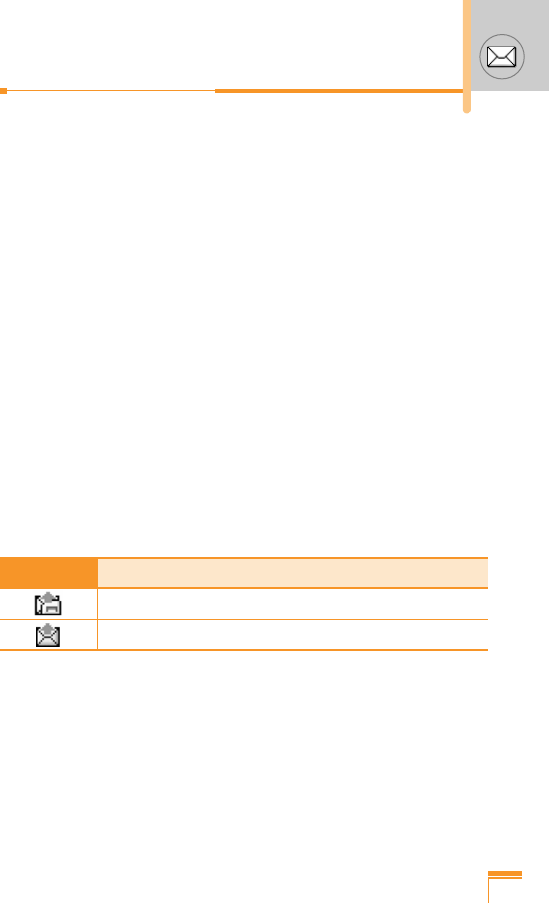
65
• Forward
Forwards a received message to other recipients.
• Return call
Calls the sender’s phone.
• Extract
Extracts a picture, animation, sound, phone number, text web
page or email address from the message. These will be saved in
My folder, Address book, or bookmarks.
• Delete
Deletes the selected message from the Inbox.
• View information
Shows more detailed information about the selected message.
Outbox [Menu 5-1-3]
You can view the list and contents of sent messages in this menu
and can also verify if the transmission was successful.
The following options are available.
• Forward
Forwards the current message to other recipients.
• Delete
Deletes the selected message from the Outbox.
Icon Description
Sent SIM message
Sent message

66
Messages [Menu 5]
• View information
Shows more detailed information about the selected message.
Draft [Menu 5-1-4]
In this menu, you can see the message list saved as draft. Scroll
through the list using the up/down navigation keys.
Each draft has the following options.
• Send
Sends the selected message to other recipients.
• Delete
Deletes the selected message.
Settings [Menu 5-1-5]
This menu lets you set up default SMS information.
• Message types
Sets the default message type between Text, Voice, Fax, Paging,
X.400, E-mail and ERMES. The network can convert the
messages into the selected format.
• Valid period
Sets the length of time for which your text messages will be saved
at the SMS center while attempts are made to deliver them to the
recipient. Possible values are 1 hour, 12 hours, 1 day, 1 week and
the maximum authorised by your network operator.
• Delivery reports
Activates or deactivates the report function. When this function is
activated, the network informs you whether or not your message
has been delivered.

67
• Reply with same service centre
Allows the recipient of your SMS message to send you a reply via
your message centre, if the service is provided by the network.
• SMS centre
Saves or changes the number of your SMS centre when sending
text messages. You must obtain this number from your service
provider.
• Bearer setting
Selects GPRS or GSM. Contact your network operator or service
provider for information related to setting a selected bearer, pricing
and connection speed.
Delete all [Menu 5-1-6]
You can delete all messages in the message memory.
Picture message [Menu 5-2]
A picture message can contain text, images, and/or sound clips.
This feature can be used only if it is supported by your network
operator or service provider. Only devices that offer compatible
Picture message or e-mail features can receive and send
multimedia messages.
Write [Menu 5-2-1]
1. Key in the text message. Using the right soft key, you can input
symbols, numbers and emoticons, or use T9 input mode.
After the text message input, press the left soft key [Done].
2. Add an image and/or sound. You can move to the next section
using the up/down navigation.
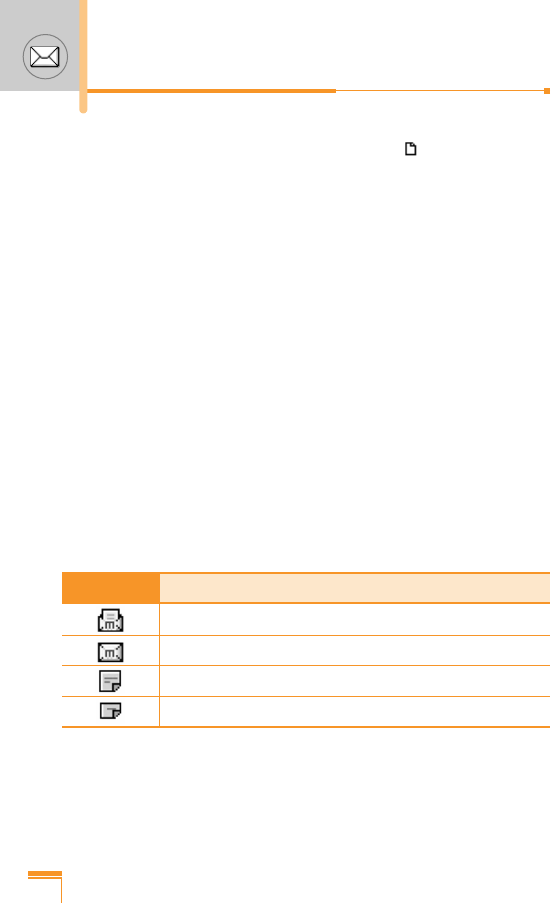
68
Messages [Menu 5]
3. You can add a slide by moving the cursor on , then pressing
the OK key or the left soft key [Select]. You can also add a slide
using the right soft key [Menu].
4. Press the right soft key [Menu]. The following options are
available.
• Send: Supports multiple numbers and email addresses.
•Preview: Displays the multimedia message you wish to send.
• Save: Saves the multimedia message in draft or as a template.
•Delete: Deletes the MMS message.
• Settings: Sets the slide show duration or aligns the message
contents right, left, top or bottom.
•Add Slide : Adds a slide before or after the current slide.
•
Remove Slide
: Deletes the selected slide.
Inbox [Menu 5-2-2]
You will be alerted when you have received messages. They will be
saved in the Inbox. You can identify each message by icons. For
details, see the icon description below.
If the phone has ‘No space for messages’, you can make space by
deleting messages, media and applications.
Icon Description
Read multimedia messages
Unread multimedia messages
Read notified multimedia messages
Unread notified multimedia messages

69
• Timer stop
The Timer stop menu is displayed when you receive a message
including various pictures. Usually, the pictures are sequentially
displayed automatically. However, if you select this menu, you can
see the next picture by pressing the left soft key [Next] manually.
• Previous slide
Displays the previous page.
• Replay
Replays multimedia messages.
• Delete message
Deletes the current message.
• Reply all
Replies to all senders.
• Forward
Forwards the selected message to other recipients.
• Save message
Saves a multimedia message in draft form or as a template.
• Save item
Extracts pictures or sounds. They will be saved in My folder or
Address book.
• Detail
Displays information about received messages; Sender’s address,
Subject (only for Multimedia message), Message date & time,
Message type, Message size.

70
Messages [Menu 5]
Outbox [Menu 5-2-3]
Use this to see sent messages. For each sent message, you can
see the delivery status.
• Timer stop
Usually, the pictures are in the form of an automatic slide show.
However, if you select this menu, you can see the next picture by
pressing the left soft key [Next] manually.
• Previous slide
Displays the previous page.
• Replay
Replays the current message.
• Delete message
Deletes the current message.
• Forward
Forwards the current message to other recipients.
• Save message
Saves a multimedia message in draft form or as a template.
• Save item
Saves items such as images, sound and attachments to a
message.
Icon Description
Sent

71
• Detail
Displays information about the outbox messages:
Subject (only for Multimedia message), Message date & time,
Message type, Message size.
• Reply
Replies to the current message.
• Reply all
Replies to all recipients of the selected message.
Draft [Menu 5-2-4]
Using this menu, you can preset up to five multimedia messages
that you use most frequently. This menu shows the preset
multimedia message list.
The following options are available.
• Send
Supports multiple member and email addresses.
• Preview
To see the draft multimedia message.
• Save
Saves multimedia messages in draft form or as templates.
• Delete
Deletes the message.
• Settings
Select to set the slide duration or align the message contents to
the right, left, top or bottom.

72
Messages [Menu 5]
• Add slide
Adds a slide before or after the current slide.
• Remove slide
Removes the highlighted slide.
Settings [Menu 5-2-5]
Via this menu, you can set up the default multimedia message
information.
The following options are available.
• Message title
Enter the message title.
• Slide duration
Set the duration of each slide.
• Alignment
Set the alignment of messages.
• Valid period
Set the duration for keeping messages on the network server.
• Auto download
On: If you select this, messages are downloaded automatically on
receipt.
Confirm: Requires you to confirm you want to download the
message.
Off: Defers downloading messages.
• Message centre URL
Enter the address of an MMS server to use the MMS service.

73
• Profiles
See page 78 for further information.
Answer phone [Menu 5-3]
This menu provides you with a quick way of accessing your voice
mailbox (if provided by your network). Before using this feature, you
must enter the voice server number obtained from your network
operator.
When new voice message is received, the ( )symbol will be
displayed on the screen. Please check with your network provider
for details of their service in order to configure the handset correctly.
Listen to voice mail [Menu 5-3-1]
Once this option has been selected, simply press the left soft key
[OK] to listen to voice messages. You can also hold down the
1 key in standby mode to listen to voice messages.
Voice mail centre [Menu 5-3-2]
You can input and set the voice mailbox number.
Info services [Menu 5-4]
Info service messages are text messages sent by the network to
mobile phone users. They provide general information such as
weather reports, traffic news, taxis, pharmacies, and stock prices.
Each type of information is associated with a number, which can be
obtained from the network operator. When you receive an info
service message, a popup message will indicate a new message
receipt or the info service message will be displayed directly.
In standby mode, the following options are available when viewing
info service messages.

74
Messages [Menu 5]
Read [Menu 5-4-1]
The list of received broadcast messages can be searched and the
cantents viewed.
Receive [Menu 5-4-2]
Use this to enable or disable the reception of broadcast messages.
Alert [Menu 5-4-3]
Set alert on or off for a new broadcast message.
Auto display [Menu 5-4-4]
If you select this option On, all received broadcast messages will be
automatically displayed.
Languages [Menu 5-4-5]
(Dependent to network and subscription)
This option lets you select the preferred languages. Cell broadcast
messages will be displayed in the selected language. If you use all
languages supported by the phone, select Automatic at the end of
the list.
Topics [Menu 5-4-6]
(Dependent to network and subscription)
To create new topics, press the left soft key [Option] then select
Add new. If you already have topics, you can cancel, edit, or delete
them by using the left soft key [Options].

75
Templates [Menu 5-5]
There are pre-defined messages in the list. You can view and edit
the template messages or create new messages. Three types of
templates are available: Text, Multimedia and Signature.
Text [Menu 5-5-1]
• Edit
Use this to write a new message or edit the selected template
message from the text template list.
• Delete
Deletes the selected template message from the text template list.
• Send text message
Use this to send the selected template message by SMS.
• Send multimedia message
Use this to send the selected template message by MMS.
• Add new
Use this to create new template.
Multimedia [Menu 5-5-2]
• Send
Sends the multimedia template. Supports multiple numbers and
email addresses.
• Preview
Displays the draft multimedia message.

76
Messages [Menu 5]
• Save
Saves multimedia messages in draft form or as templates.
• Delete
Deletes the multimedia template.
• Settings
Sets the timer for slide, text, or to align the message contents
right, left, top and bottom.
• Add Slide
Adds a slide before or after the current slide.
• Remove Slide
Deletes the highlighted slide.
• Add Image
Use this to add an image before or after the current image.
• Add Sound
Adds a sound before or after the current sound.
Signature [Menu 5-5-3]
This option helps you to make your own Signature. Key in the
name, mobile phone number, office number, Fax number, and
E-mail address.
• Edit
Use this to write a new message or edit the selected Signature.
• Delete
Use this to delete the selected signature.

77
• Send via text message
Use this to send the selected signature by SMS.
• Send via multimedia message
Sends the selected signature by MMS.
Memory status [Menu 5-6]
You can check the current memory status for SMS and MMS.

78
Media album [Menu 6]
Media album has 3 folders: Picture, Animation and Sound. You can
view, delete, or control downloaded contents. You can get pictures,
animation or sounds from WAP site, MMS or SMS. While you’re
checking each content, you can send it via SMS or MMS, edit or
delete it. You can set one in the Picture folder or Animation folder as
the wallpaper. For sounds, you can set the desired sound as the
ring tone.
Picture [Menu 6-1]
Animation [Menu 6-2]
Sound [Menu 6-3]
Memory status [Menu 6-4]
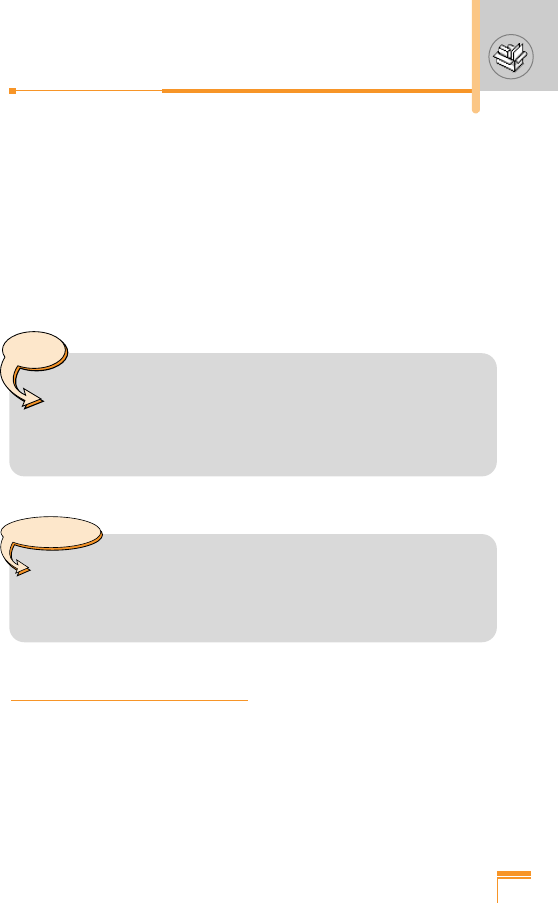
79
Apps & Games [Menu 7]
Java is a technology developed by Sun Microsystems. Similar to the
way you would download the Java Applet using the standard
Netscape or MS Internet Explorer browsers, Java MIDlet can be
downloaded using the WAP enabled phone. Depending on the
service provider, all Java based programs such as Java games can
be downloaded and run on a phone. Once downloaded, the Java
program can be viewed within the Applications menu where you can
select, execute, or delete. The Java program files saved in the
phone are in .JAD and .JAR formats.
Applications [Menu 7-1]
Application menu displays the list of Java programs downloaded
using the WAP. All previous downloaded programs can be selected,
deleted, or viewed in detail within the Application menu. From the
list within the Application menu, the following options are available:
• Open: Open the selected program. The list includes all Java
programs installed in the phone.
Note
• The JAR file is a compressed format of the Java
program and the JAD file is a description file that
includes all detailed information. From the network,
prior to download, you can view all detailed file
descriptions from the JAD file.
Warning
• Only J2ME (Java 2 Micro Edition) based programs will
run in a phone environment. The J2SE (Java 2
Standard Edition) based programs will only run in a PC
environment.

80
Note
• The control keys are different depending on a game.
However, each one has an introduction to explain the
main control keys.
[ Common key function ]
< : Game menu
> : Back
Apps & Games [Menu 7]
• Delete: Delete the selected program. Once deleted, you will not be
able to restore the program unless it is downloaded again using
the WAP.
• Details: Display detailed information on the selected program.
This includes the program name, program size, program version,
vendor information and the website address or the URL.
• Connect options: Some Java applications may require data
connection to be mode. Select one of the following options.
1. Ask first: You will be asked before the application makes the
connection.
2. Allowed: The connection is created immediately without a
notification.
3. Not allowed: No connection is allowed.
Games [Menu 7-2]
You can enjoy the games which are supported.

81
Download [Menu 7-3]
When a new Java program is downloaded using the WAP, the
address from which a download takes place is known as a
bookmark. The Java menu includes a bookmark list for downloading
Java programs and this bookmark list can be viewed from the
Download menu. You can connect, view, edit, delete, and add new
bookmarks.
• Connect: Selected address in the bookmark is used for data
connection. After successful connection, desired Java program
can be downloaded from the list.
• View: Detailed information on a bookmark can be viewed such as
the address of bookmark and title of bookmark required for
connecting to certain sites.
• Edit: Selected bookmark can be edited. Editing a bookmark is
done in the order of Address ➞Title. When creating a new
bookmark, same order is followed.
• Delete: Selected bookmark is deleted. All bookmarks can be
deleted completely from the bookmark list screen. Deleted
bookmark cannot be restored so caution is required when deleting
bookmarks.
• Add new: New bookmark is added. The same order used during
Edit bookmark applies to Add new bookmark. Select the Add new
option from the bookmark menu or when no bookmark exists, then
the Add new can be selected from the bookmark list screen.
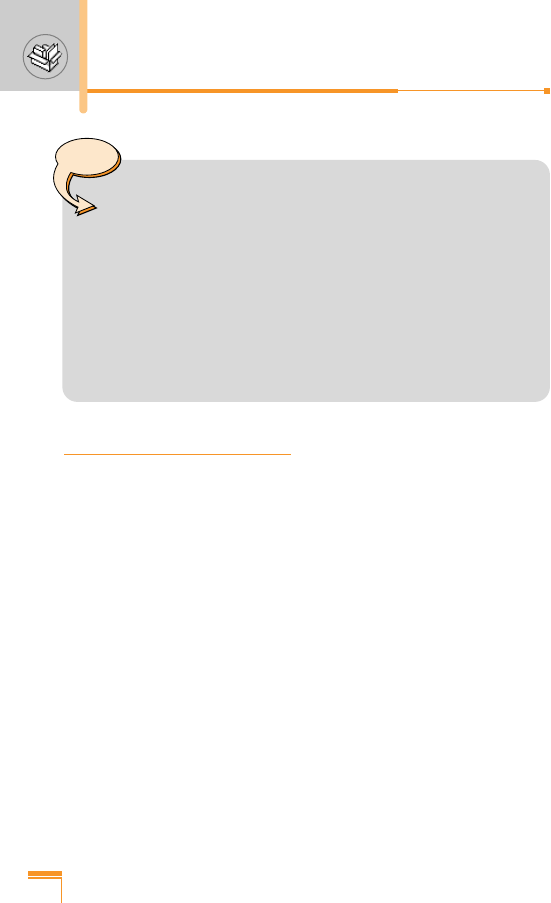
82
Note
• After selecting the Connect function to access the Java
MIDlet Provider’s server, you may choose one of many
Java programs to download and install into your phone.
Once connected to the server, the Go button can be
pressed to view the JAD information on a desired
program. The Get button will begin the download and
install process. The download and install process will
take place simultaneously and once download is
complete you can immediately run the Java program.
The installed Java program can be selected to run at a
later time from the Application menu.
Information [Menu 7-4]
Memory status [Menu 7-4-1]
Shows the size of memory available for game and application
installations. You can also see the whole memory status of
Handset.
Java version [Menu 7-4-2]
Shows the current version of Java.
Apps & Games [Menu 7]

83
Address book [Menu 8]
You can save phone numbers and their corresponding names in the
memory of your SIM card. In addition, you can save up to 255
numbers and names in the phone memory.
- Press the left soft key [Menu] in standby mode, then select
Address book.
- Or, press up/down navigation key in standby mode.
Search [Menu 8-1]
1. In standby mode, press left soft key [Menu]. Select an Address
book and select Search. Then, you are asked to enter the start
of the name that you wish to find and then, you will find the name
instantly.
2. After finding the desired name, you can make a call to the
number by pressing the [Send] key. Or press the left key
[Options] to use the following options.
• View detail: To view details of the selected name.
• Edit: Edits the name, number, and the listing group.
• Delete: Deletes the Address book entry.
• Write text msg.: Use this to write a text message to the name.
• Write picture msg.: Use this to write a picture message to the
name.
• Copy: Use this to copy the address book entry from SIM to the
phone memory or vice versa.
• Voice: Records the name of the selected address book entry
for voice-activated dialling.
• Main number: To show all number lists which are saved if
more than 2 numbers saved.

Add new [Menu 8-2]
You can add an Address book entry using this function.
There are 2 memories: Phone memory and SIM memory.
The phone memory capacity is 255 entries. You can enter up to 20
characters in each name in the phone memory. The SIM card
memory capacity depends on the SIM card.
1. Open the enu first by pressing the left soft key, and Select an
Address book.
2. Scroll to highlight Add new, and press [OK].
3. You can add new Address book entries to SIM memory or the
phone memory.
• Adding new entries into SIM memory
You can enter a name and number, and select the required
group. (Depends on the SIM)
• Adding new entries into the phone memory
You can enter a name, numbers, E-mail address, memo and
address book – photos, and select the required group.
84
Address book [Menu 8]

85
Speed dials [Menu 8-3]
You can assign any of the keys 2to 9with a name list entry.
You can make a call to the number by pressing the [Send] key, or
press the left key [Options] and select Call. Or, You can call directly
by pressing this key for 2-3 seconds in standby mode
1. Open the menu first by pressing the left soft key, and Select an
Address book [Menu].
2. Scroll to Speed dials, then press [OK].
3. To add a number to Speed dials, select <Empty> and then,
press the left soft key [Add]. You can search and select the name
to press [Select] through the address book.
4. You can change or delete a speed dial number, make a call,
write text message, or write picture message by pressing the left
soft key [Options] to use the following options.
• Change: Changes the member list.
• Delete: Deletes the member list.
• Call: Makes a call to the number.
• Write text msg.: Use this to write a text message to the name.
• Write picture msg.: Use this to write a picture message to the
name.
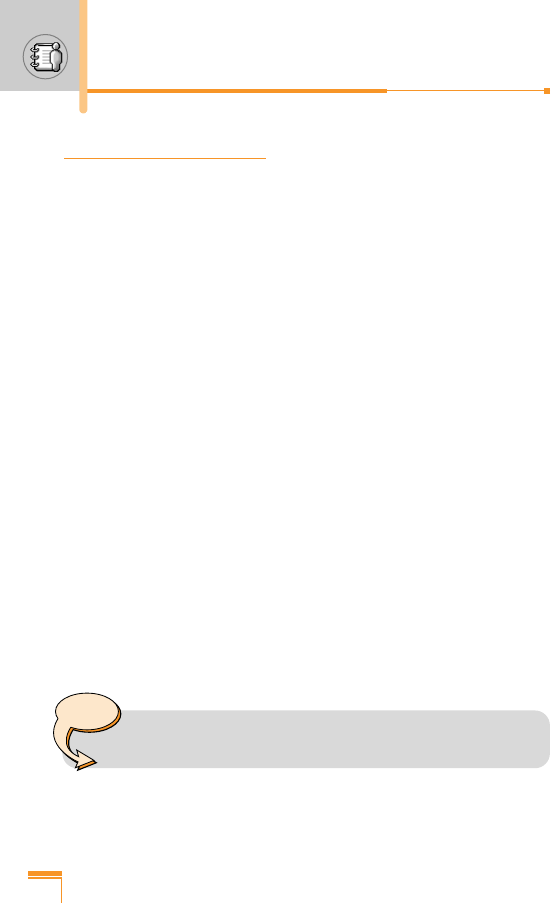
Voice list [Menu 8-4]
You can assign a voice with a name list entry for voice-acitvated
dialling.
You can make a call to the number by pressing the [Send] key, or
press the left key [Options] and select Call.
1. Open the menu first by pressing the left soft key, and Select an
Address book [Menu].
2. Scroll to Speed dials, then press [OK].
3. To add a number to Voice list, press the left soft key [Add].
You can search and select the name to press [Select] through
the address book. After selecting a number, record a voice.
4. You can play, change, or delete a voice, make a call, add new or
delete all voice lists by pressing the left soft key [Options] to use
the following options.
• Play: Plays back the voice tag assigned to the phone number.
• Change: Changes the voice tag assigned to the phone
number.
• Delete: Deletes the voice assigned to the phone number.
• Call: Makes a call to the selected number.
• Add new: Adds a new phone number for voice-activated
dialling.
• Delete all: Deletes all voice-activated dialling numbers.
86
Address book [Menu 8]
Note
• You can enter up to 10 phone numbers for voice dial.

Caller groups [Menu 8-5]
There are 6 pre-defined groups, as well as one additional group
labelled Others, where you can create lists.
1. Open the menu first by pressing the left soft key, and Select an
Address book [Menu].
2. Scroll to Caller groups, then press [OK]. Every group list will be
displayed: Family, VIP, Friends, Colleague, Group 1, Group 2,
and Others.
3. Select the group name that you want to manage by pressing the
left soft key [Options]. The following options will be displayed
except for Others.
• Member list: Displays the member list in the group.
• Group ring tone: Use this to select the ring tone to be used
when you receive a voice phone call from a person in the
group.
• Group icon: Use this to select the graphic icon to be displayed
when you receive a call from a person in the group.
• Add member: Add a member to the group.
• Delete member: Delete a member from the group.
• Rename: Assigns a new name to the group.
87

88
Copy all [Menu 8-6]
You can copy/move entries from the SIM card memory to the phone
memory and vice versa.
• SIM to Phone : Use this to copy the entry from the SIM Card to
Phone memory.
• Phone to SIM : Use this to copy the entry from the Phone memory
to the SIM Card.
The following options are available.
– Keep original : When copying, the original dial numbers are kept.
– Delete original: When copying, the original dial numbers will be
erased.
Delete all [Menu 8-7]
You can delete all entries in SIM, Phone, and Voice list. Except for
Voice list, this function requires the security code.
Settings [Menu 8-8]
Set memory [Menu 8-8-1]
You can select the memory for the Address book feature between
the SIM and the phone. If you select Variable, when adding entry,
the phone will ask where to save the number.
Photo display [Menu 8-8-2]
You can set the photo list by Photo view or List view , when you
search the Address book. If you select Photo view, the list will be
shown with photos.
Address book [Menu 8]

89
Information [Menu 8-9]
Service dial number [Menu 8-9-1]
(SIM dependent)
Use this to view the list of Service Dialling Numbers (SDN) assigned
by your network operator (if supported by the SIM card). Such
numbers include the emergency, directory enquiries and voice mail
numbers.
1. Select the Service dial number.
2. The names of the available services will be shown.
3. Use the up/down navigation keys to select a service.
Memory status [Menu 8-9-2]
You can check the current memory status of the SIM card and
phone memory.
Own number [Menu 8-9-3]
(SIM dependent)
Use this to display your phone number in the SIM card.

90
Press the Menu key (<) and select Settings using navigation
keys.
Date & Time [Menu 9-1]
This option lets you change the current time and date displayed.
The following options are available.
Set date [Menu 9-1-1]
Use this to enter the day, month and year. You can change the date
format via the Date format menu option.
Date format [Menu 9-1-2]
You can set the date format such as DD/MM/YYYY, MM/DD/YYYY,
YYYY/MM/DD. (D: Day, M: Month, Y: Year)
Set time [Menu 9-1-3]
Use this to enter the current time. You can choose the time format
via the Time format menu option.
Time format [Menu 9-1-4]
You can set the time format between 12 hours and 24 hours.
Display settings [Menu 9-2]
Many features of your phone can be customised to suit your
preferences. All of these features are accessed via the Display
settings menu.
Wallpaper [Menu 9-2-1]
Use this to set up the display on the LCD screen in the standby
mode.
Settings [Menu 9]

Greeting note [Menu 9-2-2]
Use this to show the greeting note on the internal LCD screen in the
standby mode and external LCD. Maximum number of characters
can be shown is 15 for the internal LCD and 10 for the external
LCD.
Menu colour [Menu 9-2-3]
Your Phone provides you with 4 menu colour themes. Set the menu
colour by scrolling and pressing the Select key.
Languages [Menu 9-2-4]
You can select the display language. When the language option is
set to Automatic, the language is automatically selected according
to the language of the SIM card used. English will be set if the
language on the SIM card is not supported by the phone.
Backlight [Menu 9-2-5]
Use this to select whether or not the phone uses the backlight.
A small increase in standby/talk time can be achieved by turning the
backlight off.
You set the backlight option for the keypad in the up/down position
independently.
LED Indication [Menu 9-2-6]
Use this to set LED Indication blinking on/off, which shows whether
your phone is power on.
Network name [Menu 9-2-7]
Use this to display network name you use on the LCD screen in the
standby mode.
91

Call settings [Menu 9-3]
To change the settings for call diverting.
Call divert [Menu 9-3-1]
When this network service is activated, you can direct your
incoming calls to another number, for example, to your voice
mailbox number. For details, contact your network operator. Select
one of the divert options, for example, select If busy to divert voice
calls when your number is busy or when you reject incoming calls.
The following options are available.
• All voice calls
Diverts all voice calls unconditionally.
• If busy
Diverts voice calls when the phone is in use.
• If no reply
Diverts voice calls which you do not answer.
• If out of reach
Diverts voice calls when the phone is switched off or out of
coverage.
• All data calls
Diverts to a number with a PC connection unconditionally.
• All fax calls
Diverts to a number with a fax connection unconditionally.
Each option has the following menu:
- Activate
Activates the corresponding service.
92
Settings [Menu 9]

• To voice mail
Forwards to message centre. This function does not apply to
All data calls and All fax calls menus.
• To other number
Input the number for call diverting.
- Cancel
Cancels the selected call divert.
- View status
You can check the status of the service.
• Cancel all
Cancels all call divert settings.
Answer mode [Menu 9-3-2]
Select the desired mode to answer a call.
• Flip open
You can receive a call simply by opening the flip.
• Any key
When the phone rings, you can answer a call by pressing any key
except the key and the right soft key (>).
• Only send key
You can answer a call only by pressing the send key.
Send my number [Menu 9-3-3]
This network service lets you decide whether your phone number is
displayed (On) or hidden (Off) from the person you are calling.
Select Set by network to reset the phone to the setting that you
have agreed upon with your service provider.
93

Call waiting [Menu 9-3-4]
(Network Service)
The network will notify you of a new incoming call while you have a
call in progress. Select Activate to request the network to activate
call waiting, Cancel to request the network to deactivate call
waiting, or View status, to check if the function is active or not.
Minute minder [Menu 9-3-5]
When set to On, the phone will beep every minute during an
outgoing call to keep you informed of the length of the call.
Voice dial [Menu 9-3-6]
You can make a phone call by speaking a voice tag that has been
added to a contact card. Any spoken word(s) can be a voice tag.
Before using voice-activated dialling, note that:
• Voice tags are not language dependent. They are dependent on
the speaker’s voice.
• Voice tags are sensitive to background noise. Record them and
make calls in a quiet environment.
• When recording a voice tag or making a call by saying a voice
tag, the loudspeaker is in use. Hold the phone at a short distance
away from your mouth and face so that the proximity sensor does
not turn the loudspeaker off.
• Very short names are not accepted. Use long enough names and
avoid similar names for different numbers.
• Automatic
Use this to enter voice-activated dialling mode whenever you slide
the keypad down.
• Manual
Use this to enter voice-activated dialling mode by holding the star
[*/voice] key.
94
Settings [Menu 9]

Auto redial [Menu 9-3-7]
Select On, and your phone will make a maximum of five attempts to
connect the call after an unsuccessful call attempt.
Select line [Menu 9-3-8]
This function is only used if Two Line Service is supported by the
Service Provider. If this function is supported by your service
provider, the following menu will be displayed.
• Line 1
• Line 2
Closed user group [Menu 9-3-9]
(Network Service)
This is a network service that specifies the group of people who you
can call and who can call you. For more information, contact your
network operator or service provider. If a group index is specified, it
is used for all outgoing calls. If no group index is specified, the
network will use the preferential index. (A specific index is stored in
the network.)
• Preset : Sets the selected CUG index.
• On: You can edit the CUG index and activate it.
• Off: Deletes the selected CUG.
95
Note
• You must say the name exactly as you said when you
recorded it. This may be difficult, for example, in a
noisy environment or during an emergency, so you
should not rely solely upon.

Network settings [Menu 9-4]
The Network settings feature enables you to indicate whether the
network used when roaming (outside your home area) is selected
automatically, manually or preferably.
Automatic [Menu 9-4-1]
Use this to set the phone to automatically search for and select one
of the cellular networks available in your area.
The phone will default back to Automatic if it is switched off.
Manual [Menu 9-4-2]
If you want to select the desired network manually from a list of
network. If the connection to the manually selected network is lost,
Preferred [Menu 9-4-3]
You can set a list of preferred networks the handset should attempt
to register with first, before attempting to register to any other
networks. This list is created from the handset’s predefined list of
known networks.
Band selection [Menu 9-4-4]
Use this to set the network band between two choices, GSM
900/1800 or GSM1900.
96
Settings [Menu 9]
Note
• You can select a network other than your home
network only if it has a valid roaming agreement with
your home network.
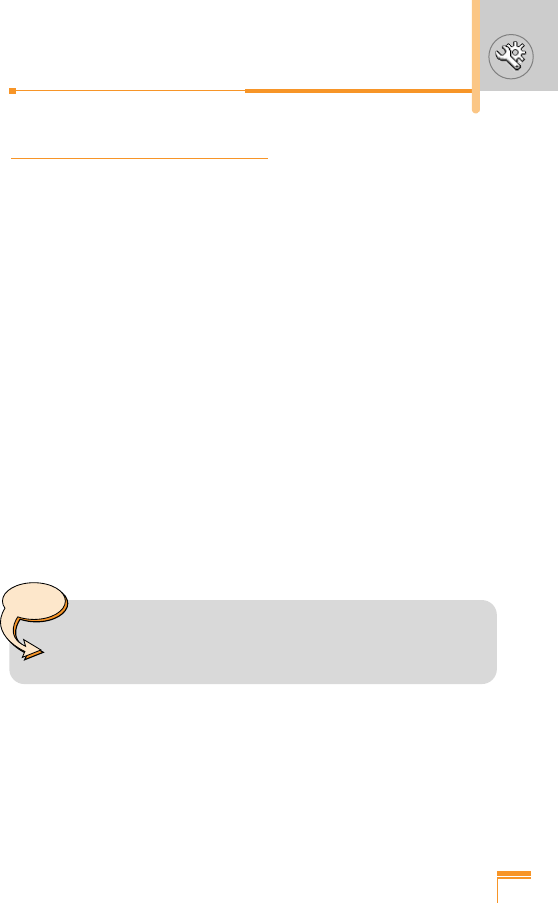
GPRS settings [Menu 9-5]
GPRS (General Packet Radio Service) is a technology that allows
mobile phones to be used for sending and receiving data over the
mobile network. GPRS is a data bearer that enables wireless
access to data network such as the Internet.
Before you can use GPRS technology;
• You need to subscribe to the GPRS service. For availability and
subscription to GPRS service, contact your network operator or
service provider.
• You need to save the GPRS settings for the applications used
over GPRS.
Attach [Menu 9-5-1]
If you select Power on and you are in a network that supports
GPRS, the phone registers to the GPRS network and sending short
messages will be done via GPRS. Also, starting an active packet
data connection, for example, to send and receive e-mail, is quicker.
If you select When needed, the phone will use a GPRS connection
only if you start an application or action that needs it. The GPRS
connection is closed after it is no longer required by any application.
External device [Menu 9-5-2]
When you use Internet via GPRS by using external device, you can
set the following six profiles: Rename, APN, IP address, DNS,
User ID, and Password.
97
Note
• If there is no GPRS coverage and you have chosen
Automatic, the phone will periodically try to establish a
connection.
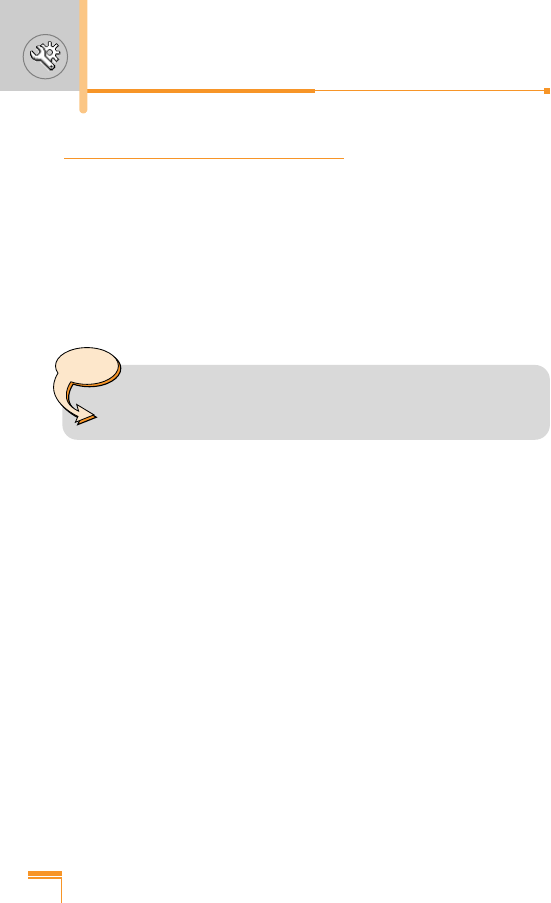
Security settings [Menu 9-6]
Various passwords are used to protect certain features of your
phone.
PIN code request [Menu 9-6-1]
When the PIN code request feature is enabled, you must enter
your PIN each time you switch the phone on. Consequently, any
person who does not have your PIN cannot use your phone without
your approval.
The following options are available:
• Enable
You must enter the PIN each time the phone is switched on.
• Disable
The phone connects directly to the network when you switch it on.
Phone lock [Menu 9-6-2]
When the Phone lock feature is enabled, the phone is locked and
you must enter the phone password each time the phone is
switched on. The password is factory set to 0000. To change the
phone password, refer to the Change codes – Security code
menu option [Menu 9-6-5-1]. Once the correct password has been
entered, you can use the phone until you switch it off.
The following options are available:
98
Settings [Menu 9]
Note
• Before disabling the PIN code request feature, you
must enter your PIN.

• Power On
- Enable
You are required to enter the phone password when you switch
the phone on.
- Disable
You do not need to enter the phone password when you switch
the phone on.
- If SIM changed
Your phone will request security code only when you change
your SIM card.
• Immediately
After entering the correct security code, the phone will lock after
going into the idle state. If you want to disable this phone lock, you
should enter the right security code after pressing the right soft
key. If you power off in the phone lock state, when the phone is
next powered on, the phone is in the lock state.
Call barring service [Menu 9-6-3]
(Network dependent)
Call barring lets you restrict the making and receiving of calls with
your phone. For this function, you need the barring password, which
you can obtain from your service provider.
The following options are available:
• All outgoing
No call can be made.
• Outgoing international
International calls cannot be made.
99

• Outgoing international except home country
When abroad, calls can be made only to numbers within the
current country and to your home country, No call can the country
where your home network provider is located.
• All incoming
No call can be received.
• Incoming when abroad
Calls cannot be received when you are using your phone outside
your home service area.
• Cancel all barrings
All call barring settings are deactivated; calls can be made and
received normally.
• Change password
Use this to set and change the call barring password obtained
from your service provider using this option. You must enter the
current password before you can specify a new one. Once you
have entered a new password, you are asked to confirm it by
entering it again.
100
Settings [Menu 9]
Note
• To use Call barring service, you must input the
network password. When calls are barred, calls may be
possible to certain emergency numbers on some
networks.
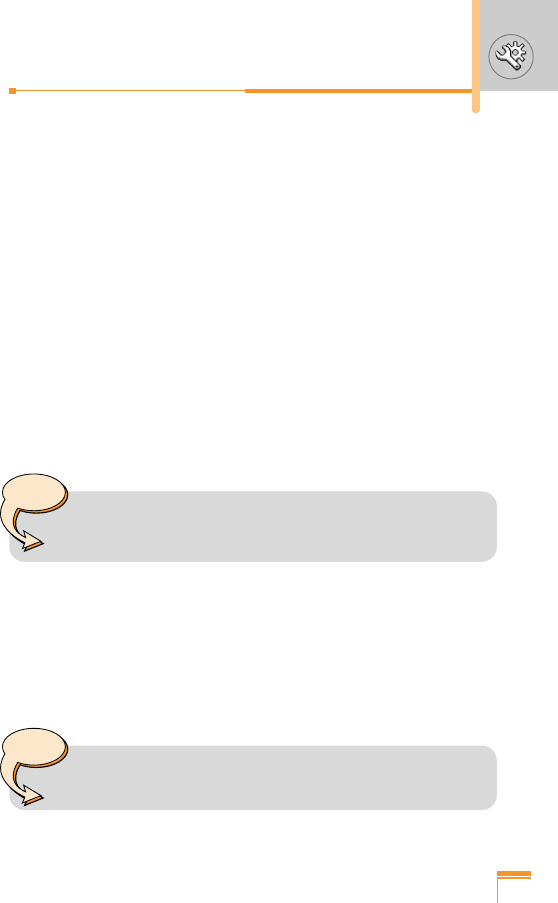
Fixed dial number [Menu 9-6-4]
(FDN) (SIM dependent)
Use this to restrict your outgoing calls to selected phone numbers,
if this function is supported by your SIM card. The PIN2 code is
required.
The following options are available:
• Activate
Use this to only call phone numbers saved in the address book.
You must enter your PIN2 code.
• Cancel
Allows you to call any number.
• Number list
Use this to view the numbers saved as fixed dial numbers.
Change codes [Menu 9-6-5]
The Change codes feature lets you change your current password
to a new one. You must enter the current password before you can
specify a new one.
Use this to change the access codes: Security code, PIN1 code,
PIN2 code
101
Note
• Not all SIM cards have a PIN2. If your SIM card does
not, this menu option is not displayed.
Note
• PIN: Personal Identification Number
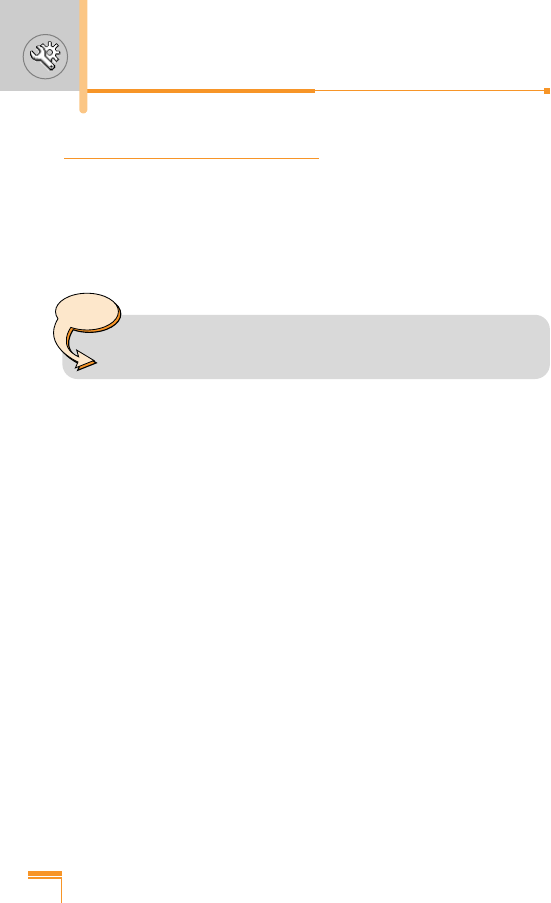
Reset settings [Menu 9-7]
You can reset your phone to its default configuration.
To do so, proceed, as follows.
1. Select the Reset settings menu option.
2. Enter the 4-digit security code.
102
Settings [Menu 9]
Note
• The security code is preset to 0000.

103
Q&A
Please check to see if any problem which you may have with your
phone is described here before taking it for service or calling a
service engineer.
QHow do I view the list of outgoing calls, incoming calls and
missed calls?
APress S.
QHow do I clear all call history?
APress the left soft key and then 2 4 4.
QHow do I view all numbers saved in the memory?
APress the right soft key and then 1.
Qdoes not disappear from the screen.
ACheck whether you are in a service area. If you continue to see
, turn off the power and wait for approximately 2 minutes
before turning it back on. If there is no change, relocate to
another area and check again.
QConnection is poor or is not audible in certain areas.
AIn certain areas, signal strength can vary dramatically. Try
moving to a different location. Heavy network traffic may affect
the ability to connect, or the stability of the call.
QConnection is poor even when established.
AIn certain areas, signal strength can vary dramatically. Try
moving to a different location. Heavy network traffic my affect
the ability to connect, or the stability of the call.

104
QLCD does not turn on.
ARemove and replace the battery and turn on the power. If the
phone still does not turn on, charge the battery and try again.
QAn echo can be heard during connection with a certain
telephone in a certain area.
AIt is called ‘Echo Phenomenon’. It occurs if the volume is too
high or caused by special properties (semi electronic telephone
exchange) of the machine on the other end.
QThe phone gets warm.
ADuring long calls, or if games/Internet are used for a long time,
the phone may become hot. This is perfectly normal and has no
effect upon the life of the product or performance.
QThe bell does not ring, or lamp or LCD blinks only.
AThe phone is set to ‘Vibrate’ or ‘Silent’ in the Profiles menu.
Please select ‘General’ or ‘Loud’
QStandby duration of the phone gradually becomes shorter.
ABatteries have a limited life. When the battery lasts for half its
original time, it requires replacement. Only use authorised
replacement parts.
QUsage time of battery becomes shorter.
AIf the battery time is short, it may be due to the user
environment, or large volume of calls, or weak signals.
Q&A

105
QNo number is dialled when you recall an Address book entry.
ACheck that the numbers have been saved correctly, by using the
address book Search feature. Resave them, if necessary.
QYou cannot be contacted.
AIs your phone switched on (E pressed for more than three
seconds)? Are you accessing the right cellular network? Have
you set an incoming call barring option?
QI cannot find the lock, PIN, or PUK code, or password?
AThe default lock code is ‘0000’. If you forget or lose the lock
code, contact your phone dealer. If you forget or lose a PIN or
PUK code, or if you have not received such a code, contact your
network service provider.

FDA Consumer Update
The U.S. Food and Drug Administration’s Center for Devices and
Radiological Health Consumer Update on Mobile Phones.
1. Do wireless phones pose a health hazard?
The available scientific evidence does not show that any health
problems are associated with using wireless phones. There is no
proof, however, that wireless phones are absolutely safe.
Wireless phones emit low levels of radiofrequency energy (RF)
in the microwave range while being used. They also emit very
low levels of RF when in the standby mode. Whereas high levels
of RF can produce health effects (by heating tissue), exposure to
low level RF that does not produce heating effects causes no
known adverse health effects. Many studies of low level RF
exposures have not found any biological effects. Some studies
have suggested that some biological effects may occur, but such
findings have not been confirmed by additional research. In
some cases, other researchers have had difficulty in reproducing
those studies, or in determining the reasons for inconsistent
results.
2. What is the FDA's role concerning the safety of wireless
phones?
Under the law, the FDA does not review the safety of radiation-
emitting consumer products such as wireless phones before they
can be sold, as it does with new drugs or medical devices.
However, the agency has authority to take action if wireless
phones are shown to emit radiofrequency energy (RF) at a level
that is hazardous to the user. In such a case, the FDA could
require the manufacturers of wireless phones to notify users of
the health hazard and to repair, replace, or recall the phones so
that the hazard no longer exists.
Although the existing scientific data do not justify FDA regulatory
actions, the FDA has urged the wireless phone industry to take a
number of steps, including the following:
106
Safety Guidelines

• Support needed research into possible biological effects of RF
of the type emitted by wireless phones;
• Design wireless phones in a way that minimizes any RF
exposure to the user that is not necessary for device function;
and
• Cooperate in providing users of wireless phones with the best
possible information on possible effects of wireless phone use
on human health.
The FDA belongs to an interagency working group of the federal
agencies that have responsibility for different aspects of RF
safety to ensure coordinated efforts at the federal level. The
following agencies belong to this working group:
o National Institute for Occupational Safety and Health
o Environmental Protection Agency
o Occupational Safety and Health Administration
o National Telecommunications and Information Administration
The National Institutes of Health participates in some
interagency working group activities, as well.
The FDA shares regulatory responsibilities for wireless phones
with the Federal Communications Commission (FCC). All
phones that are sold in the United States must comply with FCC
safety guidelines that limit RF exposure. The FCC relies on the
FDA and other health agencies for safety questions about
wireless phones.
The FCC also regulates the base stations that the wireless
phone networks rely upon. While these base stations operate at
higher power than do the wireless phones themselves, the RF
exposures that people get from these base stations are typically
thousands of times lower than those they can get from wireless
phones. Base stations are thus not the subject of the safety
questions discussed in this document.
107

3. What kinds of phones are the subject of this update?
The term ‘wireless phone’ refers here to handheld wireless
phones with built-in antennas, often called ‘cell’, ‘mobile’, or
‘PCS’ phones. These types of wireless phones can expose the
user to measurable radiofrequency energy (RF) because of the
short distance between the phone and the user’s head. These
RF exposures are limited by FCC safety guidelines that were
developed with the advice of the FDA and other federal health
and safety agencies. When the phone is located at greater
distances from the user, the exposure to RF is drastically lower
because a person's RF exposure decreases rapidly with
increasing distance from the source. The so-called ‘cordless
phones,’ which have a base unit connected to the telephone
wiring in a house, typically operate at far lower power levels, and
thus produce RF exposures far below the FCC safety limits.
4. What are the results of the research done already?
The research done thus far has produced conflicting results, and
many studies have suffered from flaws in their research
methods. Animal experiments investigating the effects of
radiofrequency energy (RF) exposures characteristic of wireless
phones have yielded conflicting results that often cannot be
repeated in other laboratories. A few animal studies, however,
have suggested that low levels of RF could accelerate the
development of cancer in laboratory animals. However, many of
the studies that showed increased tumor development used
animals that had been genetically engineered or treated with
cancer-causing chemicals so as to be pre-disposed to develop
cancer in the absence of RF exposure. Other studies exposed
the animals to RF for up to 22 hours per day. These conditions
are not similar to the conditions under which people use wireless
phones, so we don’t know with certainty what the results of such
studies mean for human health. Three large epidemiology
studies have been published since December 2000.
108
Safety Guidelines

Between them, the studies investigated any possible association
between the use of wireless phones and primary brain cancer,
glioma, meningioma, or acoustic neuroma, tumors of the brain or
salivary gland, leukemia, or other cancers. None of the studies
demonstrated the existence of any harmful health effects from
wireless phone RF exposures. However, none of the studies can
answer questions about long-term exposures, since the average
period of phone use in these studies was around three years.
5. What research is needed to decide whether RF exposure
from wireless phones poses a health risk?
A combination of laboratory studies and epidemiological studies
of people actually using wireless phones would provide some of
the data that are needed. Lifetime animal exposure studies could
be completed in a few years. However, very large numbers of
animals would be needed to provide reliable proof of a cancer
promoting effect if one exists. Epidemiological studies can
provide data that is directly applicable to human populations, but
10 or more years follow-up may be needed to provide answers
about some health effects, such as cancer. This is because the
interval between the time of exposure to a cancer-causing agent
and the time tumors develop — if they do — may be many, many
years. The interpretation of epidemiological studies is hampered
by difficulties in measuring actual RF exposure during day-to-day
use of wireless phones. Many factors affect this measurement,
such as the angle at which the phone is held, or which model of
phone is used.
6. What is the FDA doing to find out more about the possible
health effects of wireless phone RF?
The FDA is working with the U.S. National Toxicology Program
and with groups of investigators around the world to ensure that
high priority animal studies are conducted to address important
questions about the effects of exposure to radiofrequency energy
(RF).

The FDA has been a leading participant in the World Health
Organization International Electromagnetic Fields (EMF) Project
since its inception in 1996. An influential result of this work has
been the development of a detailed agenda of research needs
that has driven the establishment of new research programs
around the world. The project has also helped develop a series
of public information documents on EMF issues.
The FDA and the Cellular Telecommunications & Internet
Association (CTIA) have a formal Cooperative Research and
Development Agreement (CRADA) to do research on wireless
phone safety. The FDA provides the scientific oversight,
obtaining input from experts in government, industry, and
academic organizations. CTIA-funded research is conducted
through contracts with independent investigators. The initial
research will include both laboratory studies and studies of
wireless phone users. The CRADA will also include a broad
assessment of additional research needs in the context of the
latest research developments around the world.
7. How can I find out how much radio frequency energy
exposure I can get by using my wireless phone?
All phones sold in the United States must comply with Federal
Communications Commission (FCC) guidelines that limit radio
frequency energy (RF) exposures. The FCC established these
guidelines in consultation with the FDA and the other federal
health and safety agencies. The FCC limit for RF exposure from
wireless telephones is set at a Specific Absorption Rate (SAR) of
1.6 watts per kilogram (1.6 W/kg). The FCC limit is consistent
with the safety standards developed by the Institute of Electrical
and Electronic Engineering (IEEE) and the National Council on
Radiation Protection and Measurement. The exposure limit takes
into consideration the body’s ability to remove heat from the
tissues that absorb energy from the wireless phone and is set
well below levels known to have effects. Manufacturers of
wireless phones must report the RF exposure level for each
model of phone to the FCC.
110
Safety Guidelines

The FCC website (http://www.fcc.gov/oet/ rfsafety) gives
directions for locating the FCC identification number on your
phone so you can find your phone’s RF exposure level in the
online listing.
8. What has the FDA done to measure the radio frequency
energy coming from wireless phones?
The Institute of Electrical and Electronic Engineers (IEEE) is
developing a technical standard for measuring the radio
frequency energy (RF) exposure from wireless phones and other
wireless handsets with the participation and leadership of FDA
scientists and engineers. The standard, ‘Recommended Practice
for Determining the Spatial-Peak Specific Absorption Rate (SAR)
in the Human Body Due to Wireless Communications Devices:
Experimental Techniques,’ sets forth the first consistent test
methodology for measuring the rate at which RF is deposited in
the heads of wireless phone users. The test method uses a
tissue-simulating model of the human head. Standardized SAR
test methodology is expected to greatly improve the consistency
of measurements made at different laboratories on the same
phone. SAR is the measurement of the amount of energy
absorbed in tissue, either by the whole body or a small part of
the body. It is measured in watts/kg (or milliwatts/g) of matter.
This measurement is used to determine whether a wireless
phone complies with safety guidelines.
9. What steps can I take to reduce my exposure to
radiofrequency energy from my wireless phone?
If there is a risk from these products — and at this point we do
not know that there is — it is probably very small. But if you are
concerned about avoiding even potential risks, you can take a
few simple steps to minimize your exposure to radiofrequency
energy (RF). Since time is a key factor in how much exposure a
person receives, reducing the amount of time spent using a
wireless phone will reduce RF exposure.
111111111111111

If you must conduct extended conversations by wireless phone
every day, you could place more distance between your body
and the source of the RF, since the exposure level drops off
dramatically with distance. For example, you could use a
headset and carry the wireless phone away from your body or
use a wireless phone connected to a remote antenna.
Again, the scientific data do not demonstrate that wireless
phones are harmful. But if you are concerned about the RF
exposure from these products, you can use measures like those
described above to reduce your RF exposure from wireless
phone use.
10. What about children using wireless phones?
The scientific evidence does not show a danger to users of
wireless phones, including children and teenagers. If you want to
take steps to lower exposure to radiofrequency energy (RF), the
measures described above would apply to children and
teenagers using wireless phones. Reducing the time of wireless
phone use and increasing the distance between the user and the
RF source will reduce RF exposure.
Some groups sponsored by other national governments
haveadvised that children be discouraged from using wireless
phones at all. For example, the government in the United
Kingdom distributed leaflets containing such a recommendation
in December 2000. They noted that no evidence exists that using
a wireless phone causes brain tumors or other ill effects. Their
recommendation to limit wireless phone use by children was
strictly precautionary; it was not based on scientific evidence that
any health hazard exists.
11. What about wireless phone interference with medical
equipment?
Radio frequency energy (RF) from wireless phones can interact
with some electronic devices. For this reason, the FDA helped
develop a detailed test method to measure electromagnetic
interference (EMI) of implanted cardiac pacemakers and
defibrillators from wireless telephones.
112
Safety Guidelines

This test method is now part of a standard sponsored by the
Association for the Advancement of Medical instrumentation
(AAMI). The final draft, a joint effort by the FDA, medical device
manufacturers, and many other groups, was completed in late
2000. This standard will allow manufacturers to ensure that
cardiac pacemakers and defibrillators are safe from wireless
phone EMI.
The FDA has tested hearing aids for interference from handheld
wireless phones and helped develop a voluntary standard
sponsored by the Institute of Electrical and Electronic Engineers
(IEEE). This standard specifies test methods and performance
requirements for hearing aids and wireless phones so that no
interference occurs when a person uses a ‘compatible’ phone
and a ‘compatible’ hearing aid at the same time. This standard
was approved by the IEEE in 2000.
The FDA continues to monitor the use of wireless phones for
possible interactions with other medical devices. Should harmful
interference be found to occur, the FDA will conduct testing to
assess the interference and work to resolve the problem.
12. Where can I find additional information?
For additional information, please refer to the following
resources:
FDA web page on wireless phones
(http://www.fda.gov/cdrh/phones/index.html)
Federal Communications Commission (FCC) RF Safety Program
(http://www.fcc.gov/oet/rfsafety)
International Commission on Non-lonizing Radiation Protection
(http://www.icnirp.de)
World Health Organization (WHO) International EMF Project
(http://www.who.int/emf)
National Radiological Protection Board (UK)
(http://www.nrpb.org.uk/)
113

Consumer Information on SAR
(Specific Absorption Rate)
This Model Phone Meets the Government’s Requirements for
Exposure to Radio Waves.
Your wireless phone is a radio transmitter and receiver. It is
designed and manufactured not to exceed the emission limits for
exposure to radio frequency (RF) energy set by the Federal
Communications Commission (FCC) of the U.S. Government.
These limits are part of comprehensive guidelines and establish
permitted levels of RF energy for the general population. The
guidelines are based on standards that were developed by
independent scientific organizations through periodic and thorough
evaluation of scientific studies. The standards include a substantial
safety margin designed to assure the safety of all persons,
regardless of age and health.
The exposure standard for wireless mobile phones employs a unit
of measurement known as the Specific Absorption Rate, or SAR.
The SAR limit set by the FCC is 1.6W/kg. * Tests for SAR are
conducted using standard operating positions specified by the FCC
with the phone transmitting at its highest certified power level in all
tested frequency bands. Although SAR is determined at the highest
certified power level, the actual SAR level of the phone while
operating can be well below the maximum value. Because the
phone is designed to operate at multiple power levels to use only
the power required to reach the network, in general, the closer you
are to a wireless base station antenna, the lower the power output.
Before a phone model is available for sale to the public, it must be
tested and certified to the FCC that it does not exceed the limit
established by the government-adopted requirement for safe
exposure. The tests are performed in positions and locations (e.g.,
at the ear and worn on the body) as required by the FCC for each
model. The highest SAR value for this model phone when tested for
use at the ear is 0.714 W/kg and when worn on the body, as
described in this user’s manual, is 0.482 W/kg.
114
Safety Guidelines

(Body-worn measurements differ among phone models, depending
upon available accessories and FCC requirements.) While there
may be differences between SAR levels of various phones and at
various positions, they all meet the government requirement for safe
exposure.
The FCC has granted an Equipment Authorization for this model
phone with all reported SAR levels evaluated as in compliance with
the FCC RF emission guidelines. SAR information on this model
phone is on file with the FCC and can be found under the Display
Grant section of http://www.fcc.gov/oet/fccid after searching on FCC
ID BEJG4050.
Additional information on Specific Absorption Rates (SAR) can be
found on the Cellular Telecommunications Industry Association
(CTIA) website at http://www.wow-com.com
* In the United States and Canada, the SAR limit for mobile phones
used by the public is 1.6 watts/kg (W/kg) averaged over one gram
of tissue. The standard incorporates a substantial margin of safety
to give additional protection for the public and to account for any
variations in measurements.
115
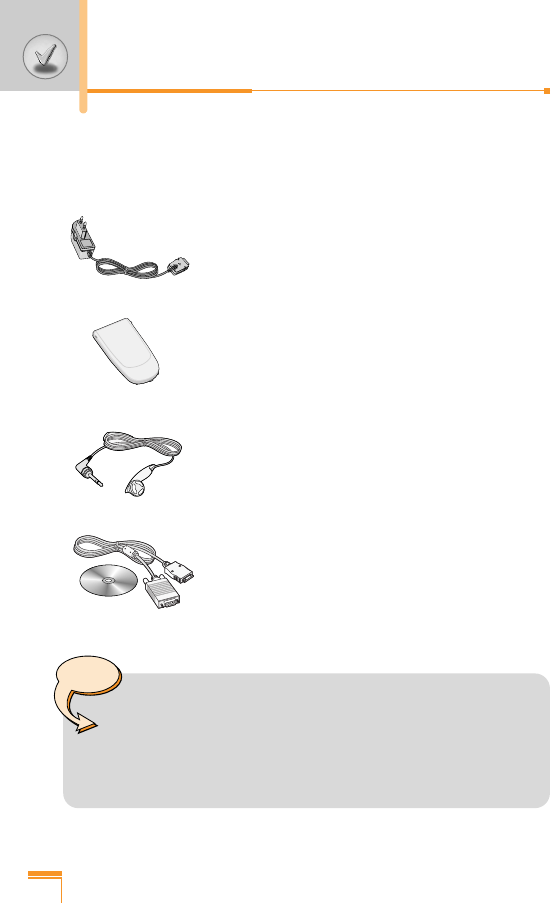
116
There are a variety of accessories available for your mobile phone.
You can select these according to your personal communication
requirements. Consult your local dealer for availability.
Supplied adapter
This adapter lets you charge the while at
home or in the office.
Battery
Standard battery is available.
Headset
Allows hands-free operation. Includes
earpiece and microphone.
Data cable kit
Connects your phone to a PC.
Note
• Always use genuine LG accessories. Failure to do this
may invalidate your warranty.
• Accessories may be different in different regions;
please check with our regional service company or
agent for further enquiries.
Accessories

117
Technical Data
General
Product name : L1100
System : GSM 900 / DCS 1800 / PCS 1900
Ambient temperatures
Max : +55
°C
Min : -10
°C

118